Paris Fashion Week A/W 2025 highlights: Chanel to Saint Laurent
Wallpaper* selects the very best of Paris Fashion Week A/W 2025, from Chanel’s playful take on its house codes to an exercise in singularity at Saint Laurent

- Saint Laurent
- Miu Miu
- Kiko Kostadinov
- Chanel
- Louis Vuitton
- Sacai
- Rokh
- Valentino
- Akris
- Balenciaga
- Duran Lantink
- McQueen
- Comme des Garçons
- Hermès
- Andreas Kronthaler for Vivienne Westwood
- Noir Kei Ninomiya
- Junya Watanabe
- Victoria Beckham
- Issey Miyake
- Givenchy
- Chloé
- Rabanne
- Rick Owens
- Schiaparelli
- Tom Ford
- Acne Studios
- Stella McCartney
- Dries Van Noten
- Courrèges
- Alaïa
- Dior
Orla Brennan
Paris Fashion Week A/W 2025 took over the French city this week with a packed schedule of runway shows from industry titans – among them Dior, Louis Vuitton, Saint Laurent, Chanel and Givenchy, the last marking the much-anticipated debut of former Alexander McQueen designer Sarah Burton.
Her opening gambit for the storied Parisian house took place on Friday morning (7 March 2025), seeing Burton draw inspiration from a cache of long-hidden patterns by house founder Hubert de Givenchy, reimagining his signatures for the woman of today. ‘I want to address everything about modern women,’ she said. ‘Strength, vulnerability, emotional intelligence, feeling powerful or very sexy. All of it.’
Elsewhere, Haider Ackermann made his debut at Tom Ford on Wednesday evening (5 March), having succeeded Peter Hawkings earlier this year; Julian Klausner held his first show as creative director of Dries Van Noten at the Opéra Garnier (also on Wednesday), while Alessandro Michele unveiled his sophomore ready-to-wear collection for Valentino in a surreal, red-hued ‘public bathroom’ (those awaiting Matthieu Blazy at Chanel, though, will have to wait until September for his official arrival).
A handful of intriguing younger names also populated the schedule, including LVMH Prize-winning designers Duran Lantink and Hodakova, while the usual contingent of Japanese designers – among them Rei Kawakubo’s Comme des Garçons, Junya Watanabe and Noir Kei Ninomiya – presented typically thought-provoking collections on Saturday (8 March 2025).
Here, Wallpaper* fashion features editor Jack Moss – with additional reporting from Orla Brennan – unpacks the best of Paris Fashion Week A/W 2025.
Saint Laurent
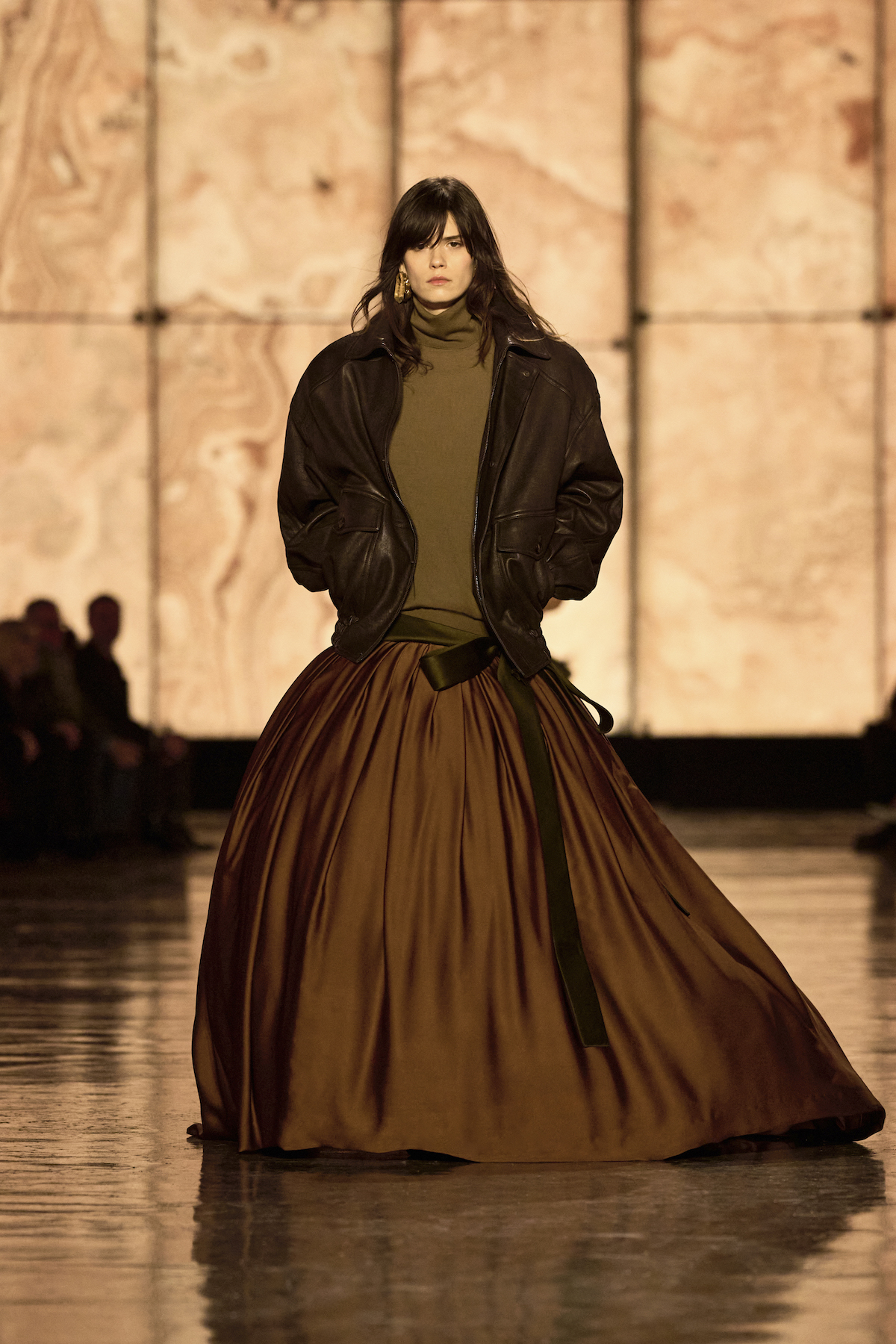
A ‘simplicity of silhouette – as if created with a few pencil strokes’ is how Anthony Vaccarrello described his masterful A/W 2025 collection for Saint Laurent, which replaced Louis Vuitton this season as Paris Fashion Week’s finale. Now adept at visual spectacle – sleek, monolithic runway sets have become a hallmark of his tenure – Vaccarrello staged this season’s show on what he called ‘a grand onyx oval’, the oil-slick black runway surrounded by panels of mineral rock.
The collection itself was an exercise in singularity, the mining of a silhouette over and over: from the broad shoulder and raised neckline of the collection’s opening looks (this season achieved without use of padding, but instead through the garment’s construction) towards enormous full skirted-gowns, which despite their grandeur, recalled nighties or slips (‘I really liked this idea of elasticity, of movement—all to give a sense of freedom,’ he said). A richness of fabric and colour enlivened these singular looks, from guipere lace and richly-hued satin to a plasticky animal-print material achieved by dipping printed cigaline silk into resin. It made for a transfixing closing act. JM
Wallpaper* Newsletter
Receive our daily digest of inspiration, escapism and design stories from around the world direct to your inbox.
Miu Miu
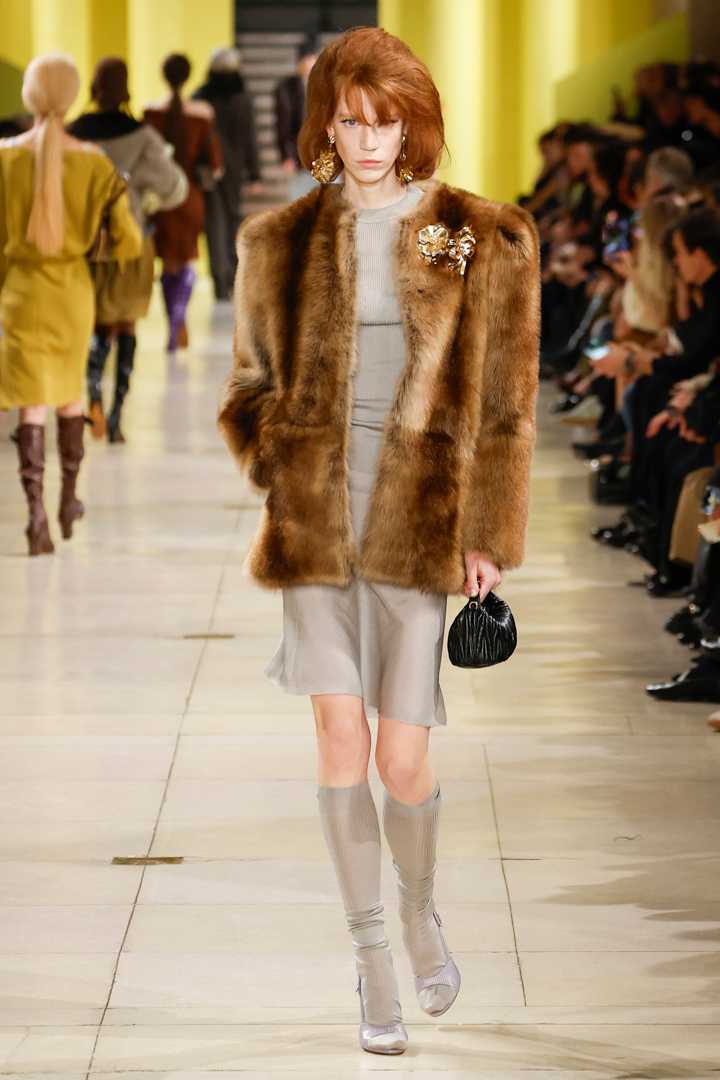
Earlier this month in Milan, Miuccia Prada – alongside co-creative director Raf Simons – presented an A/W 2025 Prada collection titled ‘Raw Glamour’. ‘We asked ourselves – what is feminine? What is feminine beauty?’ the designer said at the time, conjuring a dishevelled elegance which confronted notions of conventional beauty. At Miu Miu, the designer – here working solo – continued that interrogation of womanhood with a collection which saw her evoke the symbolic markers of feminine dress, from fur stoles and pointed bras to handbags and heels. ‘These accessories of femininity – bras, furs, brooches – they are things we have had forever. Are they relevant today? Do they lift us up?’
The resulting collection captured a mood of bourgeois Milanese glamour: oversized overcoats were worn with a ‘fur’ stole thrown over the arm and ladylike handbag nestled in its crook, delicate ribbed socks worn with shuffling brown loafers, while blazers were pinned with brooches on each side of the chest. ‘I don’t see these things as clichés,’ she asserted backstage, though they were presented here in disruptive manner: from the pointed bra tops which jutted outwards from beneath delicate, sugary knits, to the construction of the tailoring which was folded strangely at the chest or cut to fall purposely off the shoulder (other jackets were cropped as if sliced in half).
Played out in a surreal showspace covered in girlish yellow moiré on a cast which included actress Sarah Paulson and musician Cortisa Star, these ‘accessories of femininity’ were recast as objects of power – a provocative pitch for independence from the perception-shifting designer. ‘We need femininity in this difficult time to lift us up,’ she said. JM
Kiko Kostadinov
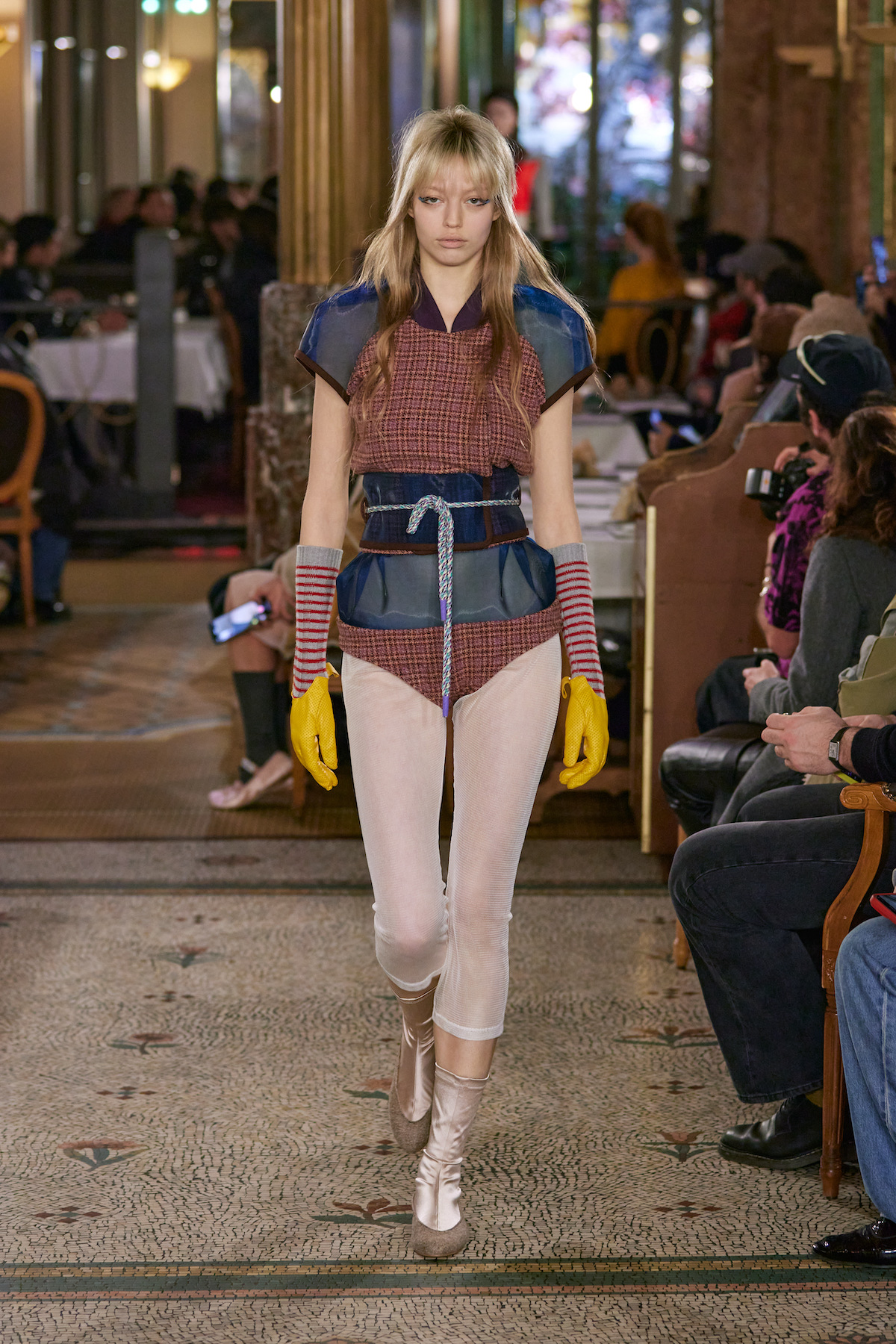
Laura and Deanna Fanning staged their A/W 2025 show for Kiko Kostadinov in Brasserie Mollard – a 130-year-old restaurant on Rue Saint-Lazare covered in its original Belle Époque gilded tiling, where guests were seated around white linen-covered tables as if about to have lunch. The charm of the largely unchanged eatery set the perfect scene for the identical twin design duo’s latest collection, which explored the ‘rakish’ spirit of discovering yourself in a new city. Their muse for the season was Vali Myers, an Australian dancer who moved among Paris’ bohemian set in the 1950s, imagining her ‘gallivanting bravely through the city as the sun rises, just a topcoat thrown over a slip’.
The resulting collection was one of the sisters’ sexiest yet. Taking shape around vintage women’s underpinnings, pointed bras and structured crinolines gave the body an angular sensuality, while a louche softness emerged in lingerie-informed abstract paisley appliqués, liquid darted blouses, and ultra-thin knitwear layers that clung close to the skin. Always offsetting the girly with something rougher, the Fannings looked to the rebellious Teddy Girls – working-class teenagers in 1950s London who wore Victorian-era menswear – and the masculine layering of the modern ‘tomboy’. Suiting and shirting came in skew-whiff shapes and piratey stripes, baggy Japanese denim was splattered with paint, and rounded batwing jackets and tiny cigarette trousers were fastened with rope. Textures and colours, meanwhile, were eccentrically mashed – mohair, moleskin, and alpaca came in primary colours merged with earthy tones – while accessories took on ‘personalities’, from a doctor’s bag to a sprite’s pointed cap.
A display of depth and originality, the collection affirmed the sister’s confidence in the Kiko Kostadinov woman they have been building together since 2018 – one that has been embraced by a devoted community of women around the world. ‘We are thinking of women taking up their bodies, being sexual and monumental, strong minded and soft,’ they said following the show. ‘Finding a path for oneself in the in-between of opposites, the way only a woman can.’ OB
Chanel
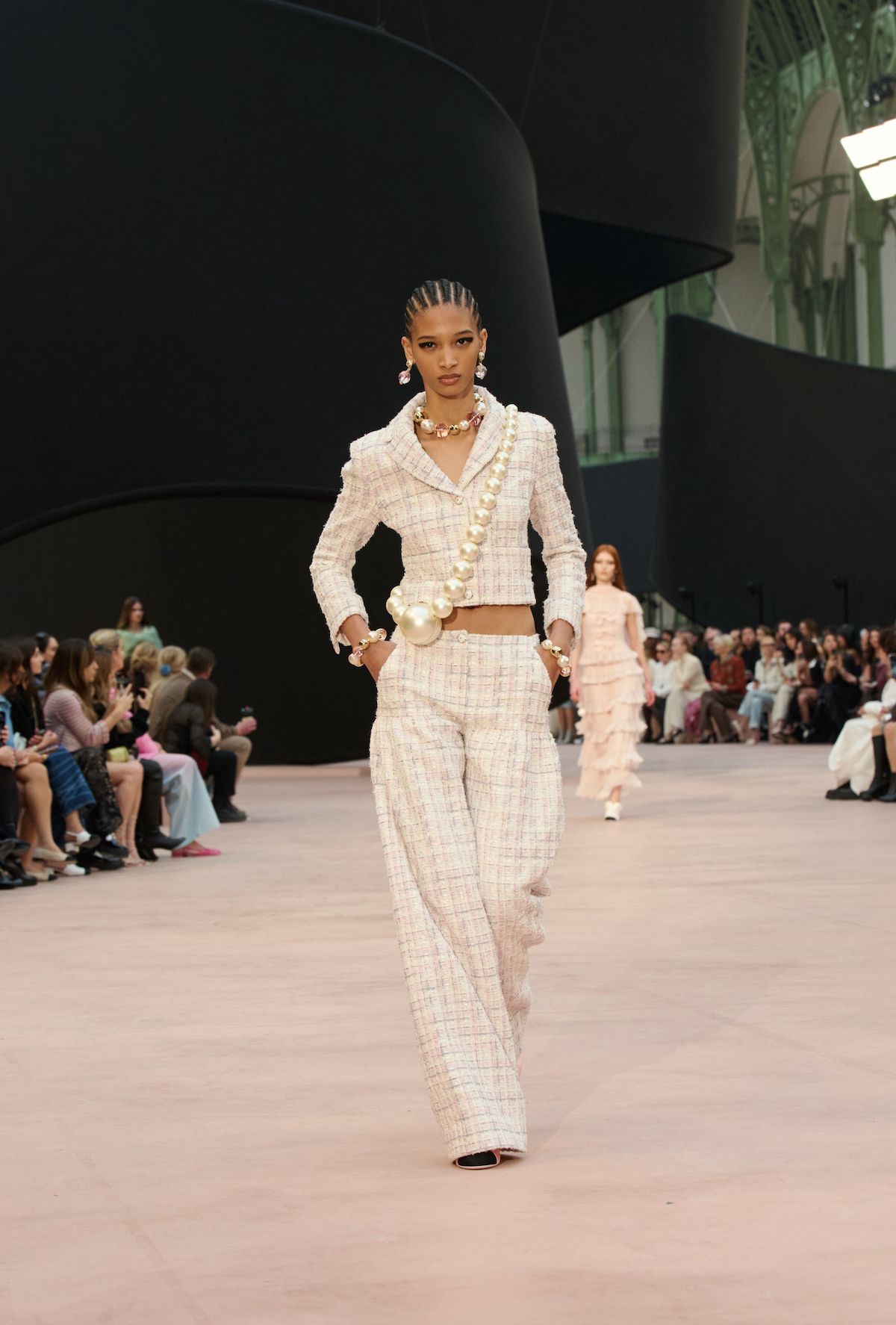
A monumental installation by Canadian designer Willo Perron, evocative of an unfurled black ribbon – a perennial Chanel signature – backdropped the house’s A/W 2025 collection. Designed by Chanel’s ‘Creation Studio’ as the house awaits the arrival of Matthieu Blazy (the former Bottega Veneta designer will not present his first collection until September), it was a collection designed to ‘alter perceptions’, whether through size and proportion, or illusory tricks. This was largely achieved through reimagining Chanel emblems – from pearls, ribbons and bows to quilted handbags and tweed suits – in imaginative ways, whether enormous pearl necklaces worn like a sash (they were actually handbags), shimmering trompe l’oeil bows, or cleverly layered tweed ‘three pieces’, comprising a shrunken jacket, wrap skirt and loose-cut trousers worn at once. The idea of illusion continued in degradé ‘denim’ shirts and jeans in printed chiffon, while sheer tulle overlays – sitting over tailored jackets and dresses – had a spectral effect. The result was a collection both playfully surreal and reassuringly Chanel, the perfect placeholder as we await Blazy’s much-anticipated ready-to-wear debut next season. JM
Louis Vuitton
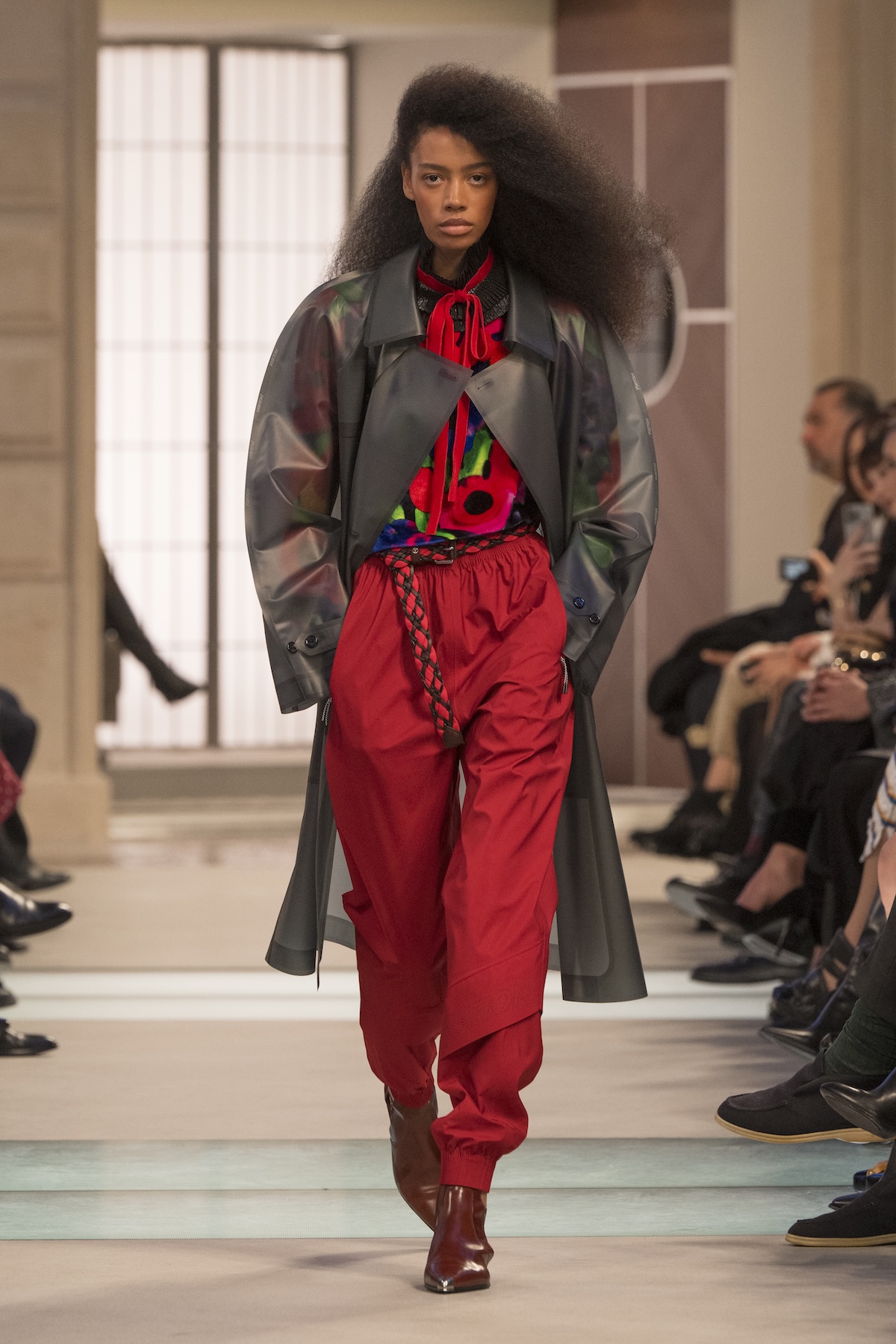
Presenting to just 400 guests – a relatively intimate showcase by Louis Vuitton standards – Nicolas Ghesquière staged his A/W 2025 collection for the house at L’Étoile du Nord, the headquarters of France’s national railway, just next door to Gare du Nord train station. ‘Recreating the bustling atmosphere of a Parisian train station – where fleeting moments are shared between strangers, weaving a tapestry of stories’, the designer explained of the roots of the collection, which played out in a set by Es Devlin, featuring rows of colourful metal seating – a surreal play on the furniture of waiting rooms or train platforms – while film projections of the shadows of travellers-on-the-move appeared around the upper windows of the building’s atrium.
As such, the collection itself comprised a series of characters one might encounter at a train station – albeit with Ghesquière’s eclectic, postmodern sheen. There were colourful raincoats and anoraks, some with a sporty Louis Vuitton logo; business-like trenches and pussybow ties; futuristic ‘uniforms’ recalling those of conductors or attendants; while expressions of old-world glamour, from twisting turban headwear to glittering fur coats and flouncy ruffled dresses recalled what Ghesquière called ‘the excitement of 19th-century rail travel… [a world of] adventure and enchantment.’ Bags, unsurprisingly, were a highlight – slouchy holdalls, slung over the shoulder, met violin and hat cases, blanket bags and vanity boxes – while the cover of Kraftwerk’s 1977 album ‘Trans-Europe Express’ became a motif throughout the collection.
‘The euphoria of discovery… the exhilaration of travel,’ Ghesquière described of the show, which culminated in the models watching over the space from the atrium’s balconies. ‘The enthusiasm of departure or the comfort of return.’ JM
Sacai
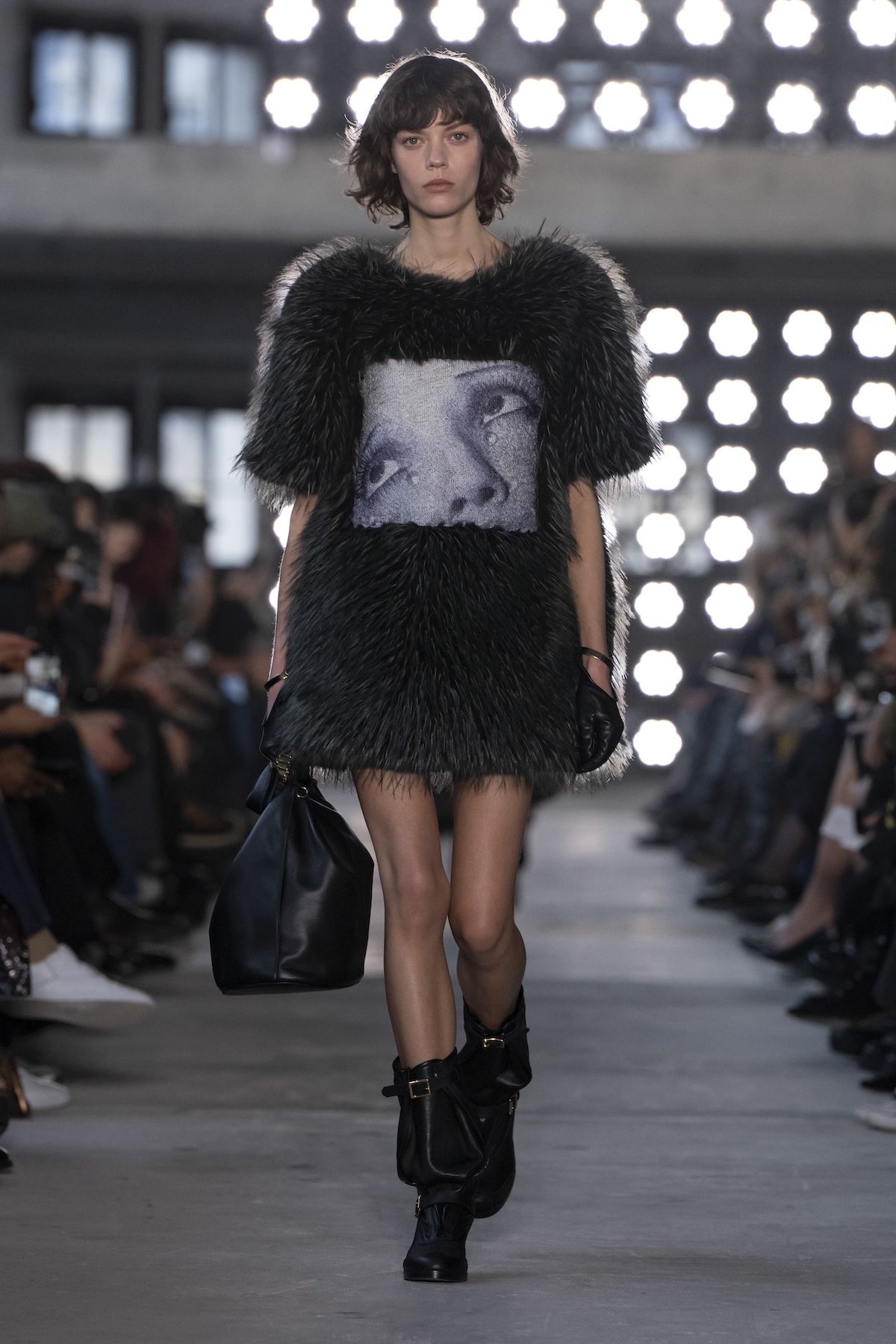
This season, Sacai’s Chitose Abe was thinking about the rituals of dressing with a collection titled ‘One Tender Moment’. Namely, the idea of ‘wrapping’ – how we wrap fabrics around our body for warmth, protection or comfort. As ever, this was achieved through adept pattern cutting (she worked as a pattern maker for both Comme des Garçons and Junya Watanabe before starting her own label), with garments which twisted and looped around the body, like the blazer transforming into forms reminiscent of capes or enormous scarves. The silk foulard was a symbolic motif of the collection’s thrown-on mood, transforming into twisted handkerchief dresses or inset into jackets. Meanwhile, flourishes of adornment – from faux-feather appliqué to oversized paillettes – gave the collection an insouciant, sensual glamour, which Abe said was also reflected in the evocation of Man Ray’s teardrop works in ‘photo stitch’ embroidery. ‘[They] highlight the lips and the eyes – the purest essence of sensual beauty,’ she said. JM
Rokh
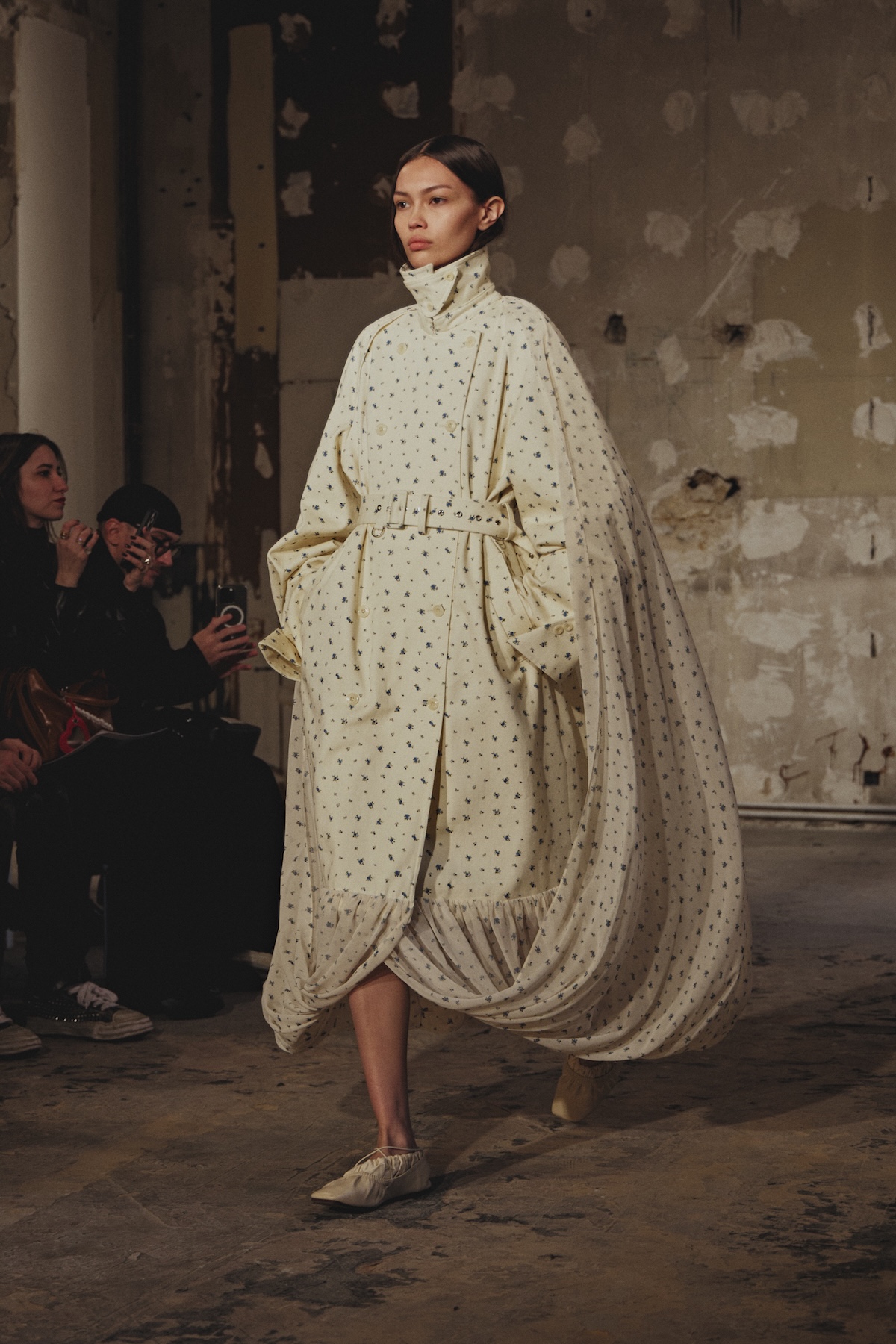
Rok Hwang designs his clothes for shy girls – women who might not be the loudest in the room, but who want their wardrobe to relay a certain strength about who they are. This season, the Korean-American designer and Celine alum (Hwang was at the brand during the Phoebe Philo years) explored the idea of ‘Fractured Motion’, applying his signature style of deconstruction and poetic drape to a muted, chalky wardrobe that played with ideas of fragility. Guests were invited to a crumbling French maison to see the show unfold, its rough grandeur setting the stage for a collection that balanced structure and spontaneity. Rather than lean into pure romance, Hwang subverted the tropes of classic tailoring, turning rigid forms into fluid sculptures. Wool coats bloomed into floral shapes, sculptural dresses clung and collapsed in unexpected ways, and layered fabrics gave the feeling of perpetual motion. A series of body pieces were Hwang’s most theatrical – strict, corset-like structures with unravelling edges, and illusion pieces that made models’ torsos resemble the marble busts of Rodin. A love letter to the sensitive souls who have supported his brand since he launched in 2016, this was Hwang at his most experimental and refined. It was about ‘tradition and boldness silently told,’ he said of the collection following the show. OB
Valentino
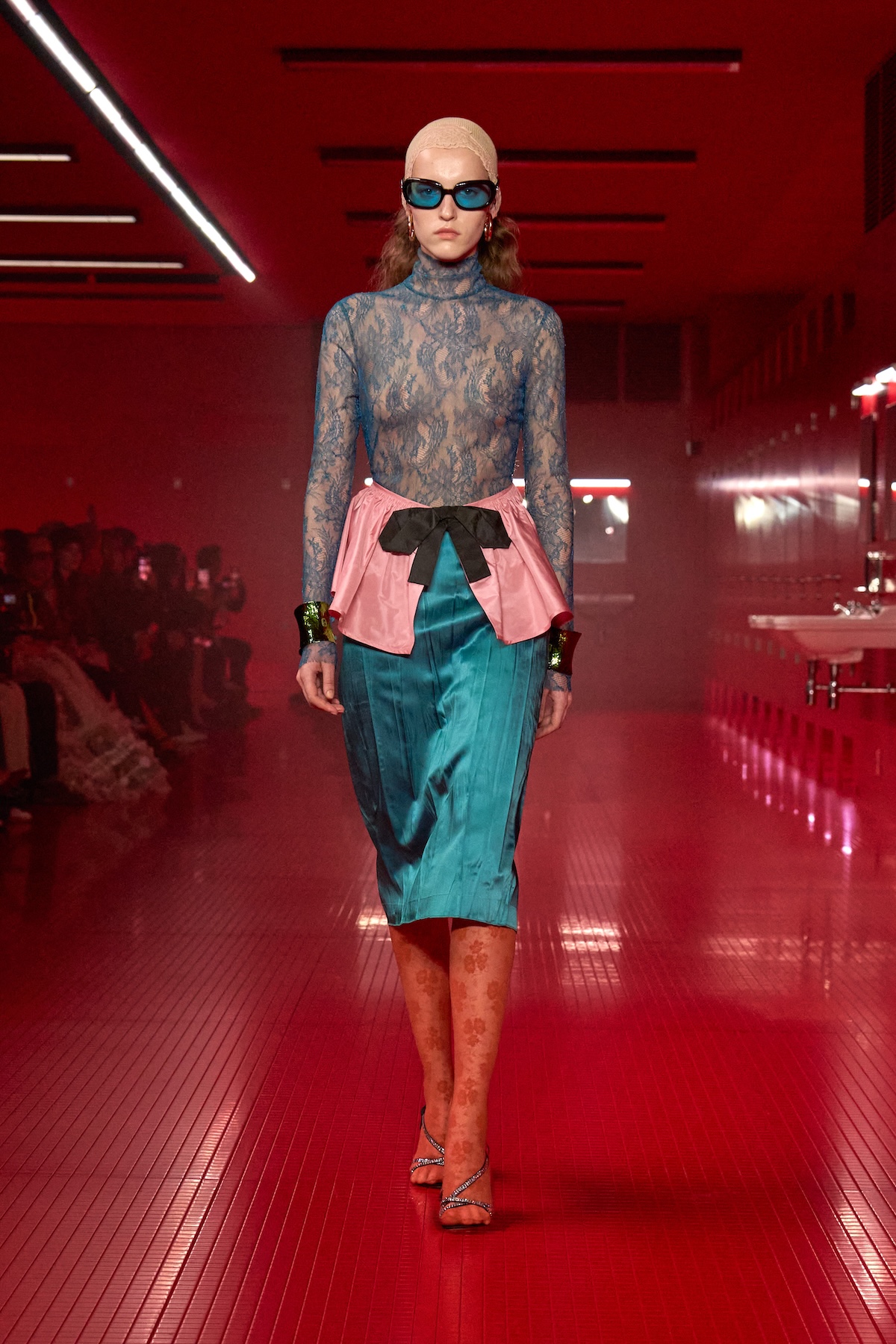
Alessandro Michele brought his flair for the theatrical to his sophomore ready-to-wear outing for Valentino, which unfolded in a specially constructed showspace at Paris’ Institut du Monde Arabe. Evocative of an enormous public bathroom – cubicles ran around the edge of the room, as did sinks and mirrors – the red-hued space provided a surreal but cinematic backdrop for a show exploring ‘ideas of private and public, surfaces and depths’ (Michele called the set ‘Lynchian’). Titled ‘Le Méta-Théâtre des Intimités’, the designer explained in his typically esoteric show notes (references included the philosophers Romano Màdera and Ludwig Wittgenstein), that this was a show about intimacy as performance: before the models emerged from the swinging cubicles, we saw glimpses of feet from beneath the door, as if the person inside was stood in the nude.
It set the stage for a sensually charged collection from the designer: undone lace body suits were inset with narrow satin bras, 1970s-style dresses in clashing shades of red and pink, while thrown-on ‘fur’ coats had a hedonistic glamour. If not stripped back – Michele remains a maximalist at heart – there felt like new clarity to this collection, pulling back some of the more extraneous flourishes of last season towards a harder vision of glamour. Indeed, the collection felt like it was unfolding in the bathroom of a nightclub, with models prowling the space, checking their outfits in the sink mirrors, before disappearing away back into the cubicles. What they were doing inside – and with whom – was left to the imagination. ‘The deepest intimacy is theatre,’ Michele concluded, having put on his own thrilling – and seductive – show. JM
Akris
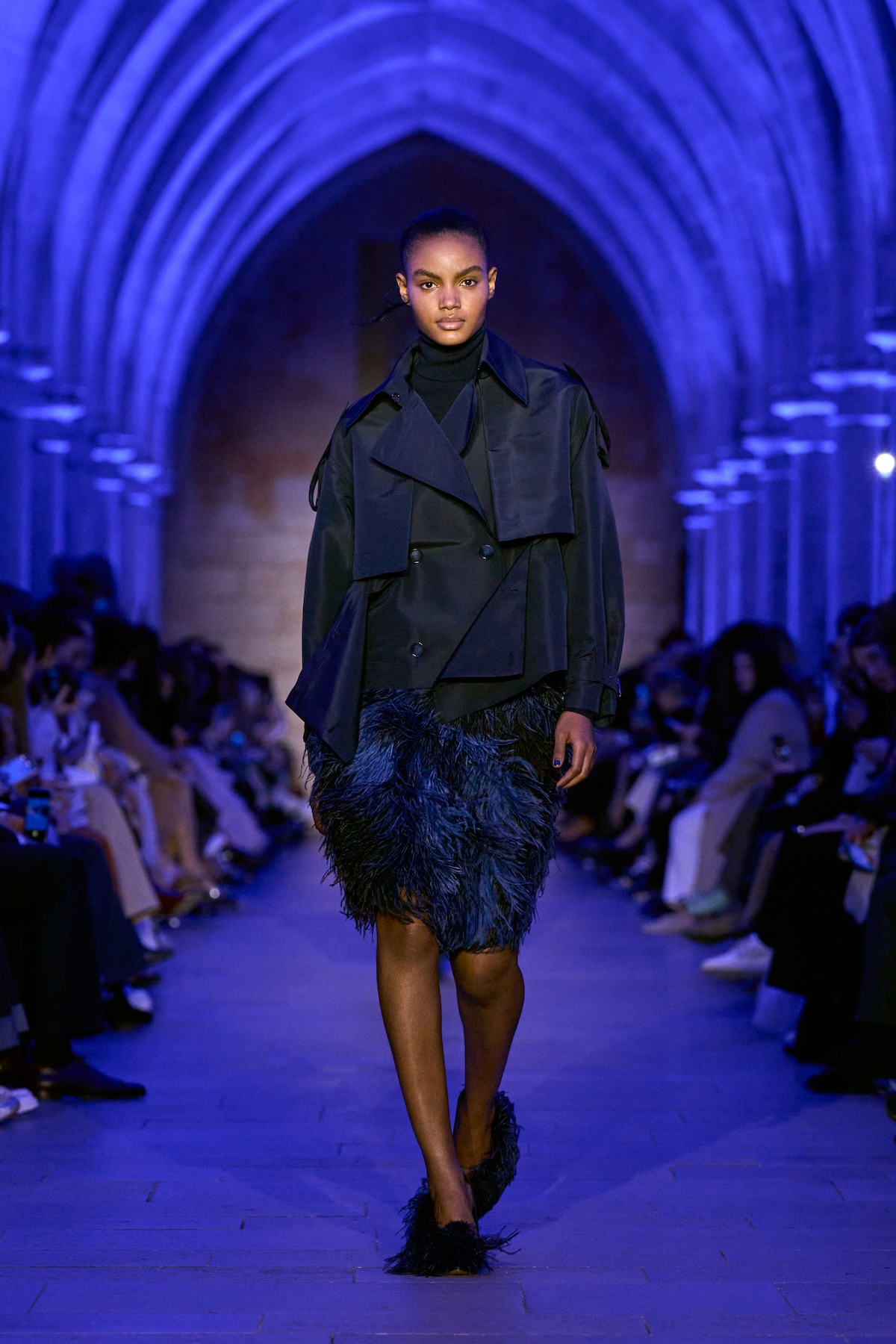
The vaulted main hall of Le Collège des Bernardins, a former Cistercian refectory, was flooded with blue light for Albert Kriemler’s latest Akris outing, which celebrated the evocative power of the hue. Titled ‘The Blue Hour’, the designer called it ‘a story of clarity, of euphoria, of blue – blue in nature, blue in spaces, blue in artworks, just blue,’ which began by thinking about the moment ‘when day and night cross.’ As such, garments melded codes of day and eveningwear: a macintosh-style jacket, sliced away at the waistline, was reimagined in rich midnight-blue velvet, a ribbed-knit sweater worn with a floating organza skirt, while a zip-up hoodie was adorned with hundreds of iridescent blue paillettes. Feathers were a motif that ran throughout, whether sprouting from a high-heeled pump or in blue and black waves across the collection’s closing look. Kriemler said he wanted them to ‘evolve with movement, continuously changing as they follow the body [and] right to the next party.’ JM
Balenciaga
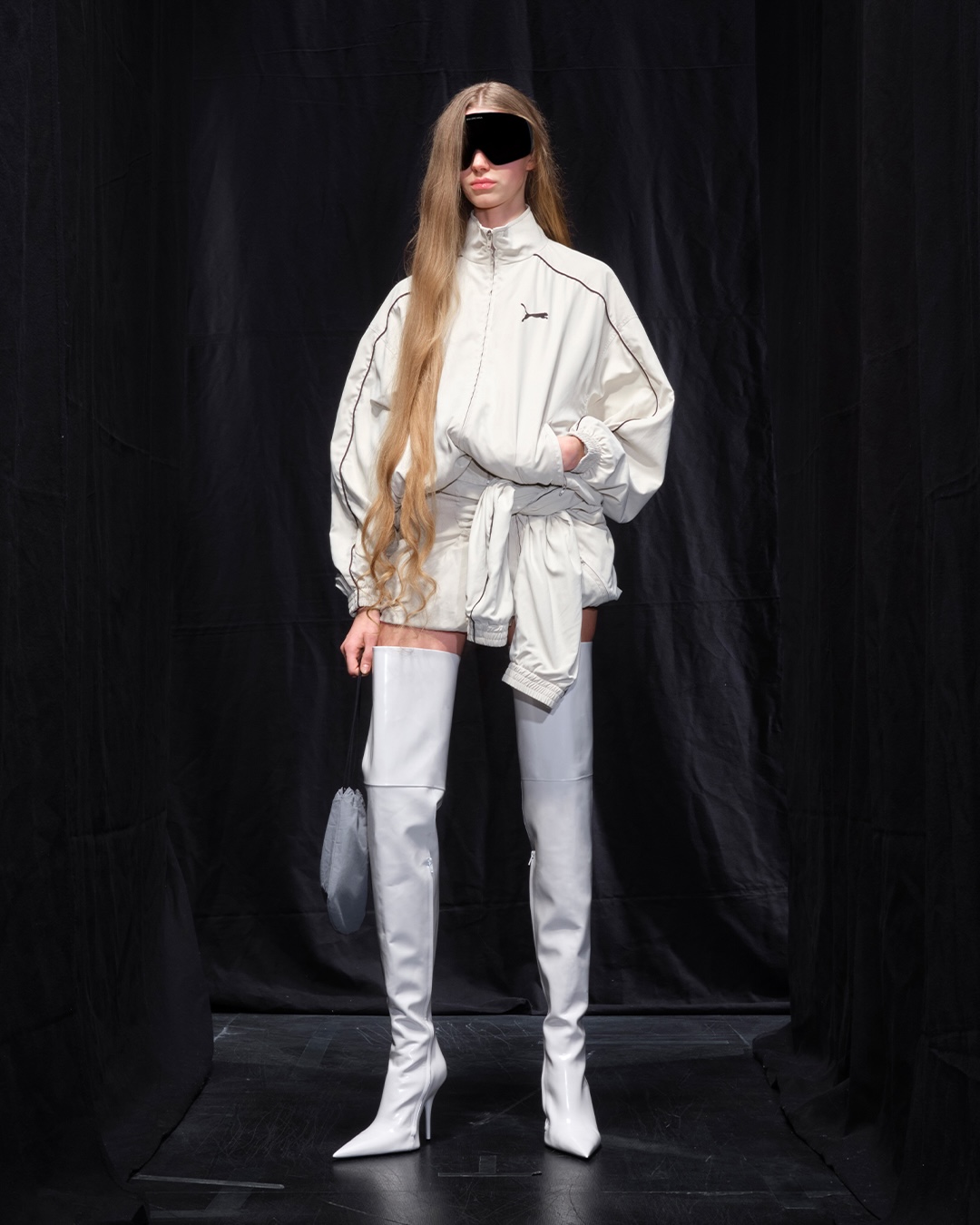
Demna staged his latest collection on a darkened, labyrinthine runway with ‘multiple entrances and exits’ which the Georgian designer likened to the way you can lose yourself in the creative process. Though having established such a design signature of the house, namely a subversive take on wardrobe archetypes, this was a collection which saw Demna continue, clear-minded and defiant, down his own path. He called the collection, which attendees viewed from up close (everyone had a front-row seat), a study of ‘standard dress codes, and what it takes to twist standard fits and garments into a fashion context… a sociological observation of the wardrobe.’ As such, the catalogue of looks – which moved between sharp, corporate attire, twisted sportswear (a collaboration with Puma featured) and dishevelled eveningwear, with lace and polka dot dresses hiked up to reveal the leg – felt like a revisiting of Demna’s greatest hits, albeit here with new rigour (he talked about a ‘pursuit of the golden ratio… a rethinking of standards’). Highlights included a series of furry-hooded puffer jackets whereby the quilting had been cleverly reworked to recall the shape of a corset or bodice, or tailoring with deep, in-set creases – reminders of the designer’s potent ability to reimagine the familiar anew. JM
Duran Lantink
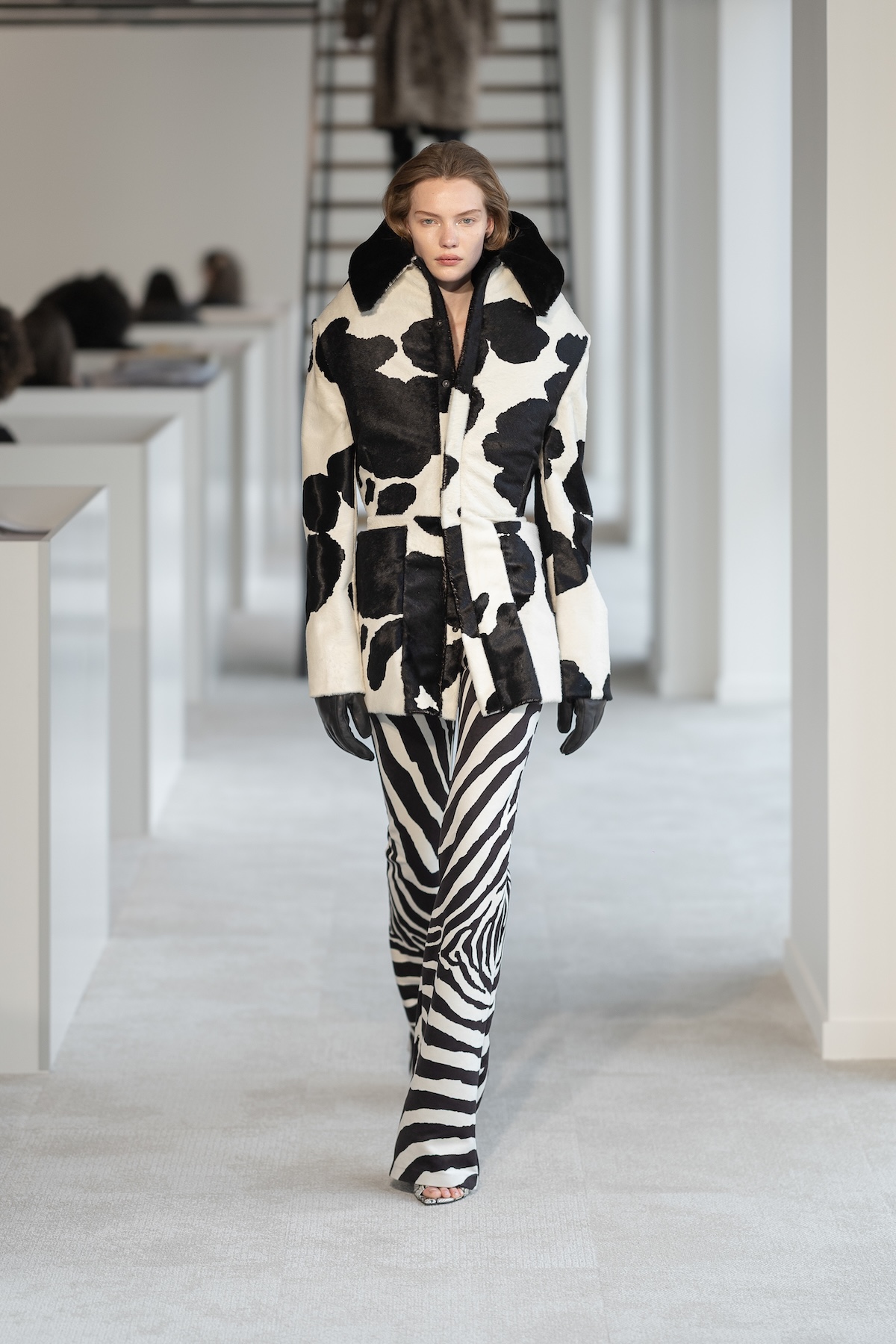
Duran Lantink invited guests down to an office space – soon to be fashion-favourite design studio Bureau Betak’s new HQ – lined with cubicles to see his A/W 2025 runway unfold. One might have expected a collection of grey office-core formality to have appeared, but that would have been too on the nose for Lantink. Instead came a series of brash, sculptural creations that played with animal prints and ideas of ‘bad taste’. Moving away from the padded bubble forms that have defined previous seasons, more tapered silhouettes used the body as a framework for dramatic character-building; jackets in zebra-print pony hair rose up to the earlobes, velvet leopard print hugged heads in balaclavas and legs in flared trousers, and snakeskin fabric became alien-like neck-swallowing bodysuits. Taking his signature three-dimensional sculpting to wry new territories, the LVMH Prize-shortlisted designer self-titled the collection ‘Duramnimal.’
Mixed in with these jungle prints, a storyline of absurdist Americana ran through battered varsity jackets, camo prints, padded trapper caps and oversized denim that was constructed to have the illusion of floating in front of models' hips. Having his fun with small town Southern aesthetics, one pair of jeans even took the style of assless chaps. But it was the opening and closing looks that were the most talked about – Mica Argañaraz in an Action Man-style latex six-pack torso, and a male model with waxy, swinging boobs. ‘I love the idea of women as action figures,’ the designer said in explanation. ‘I think everyone should feel empowered to create their own identity and not feel restricted by anything.’ OB
McQueen
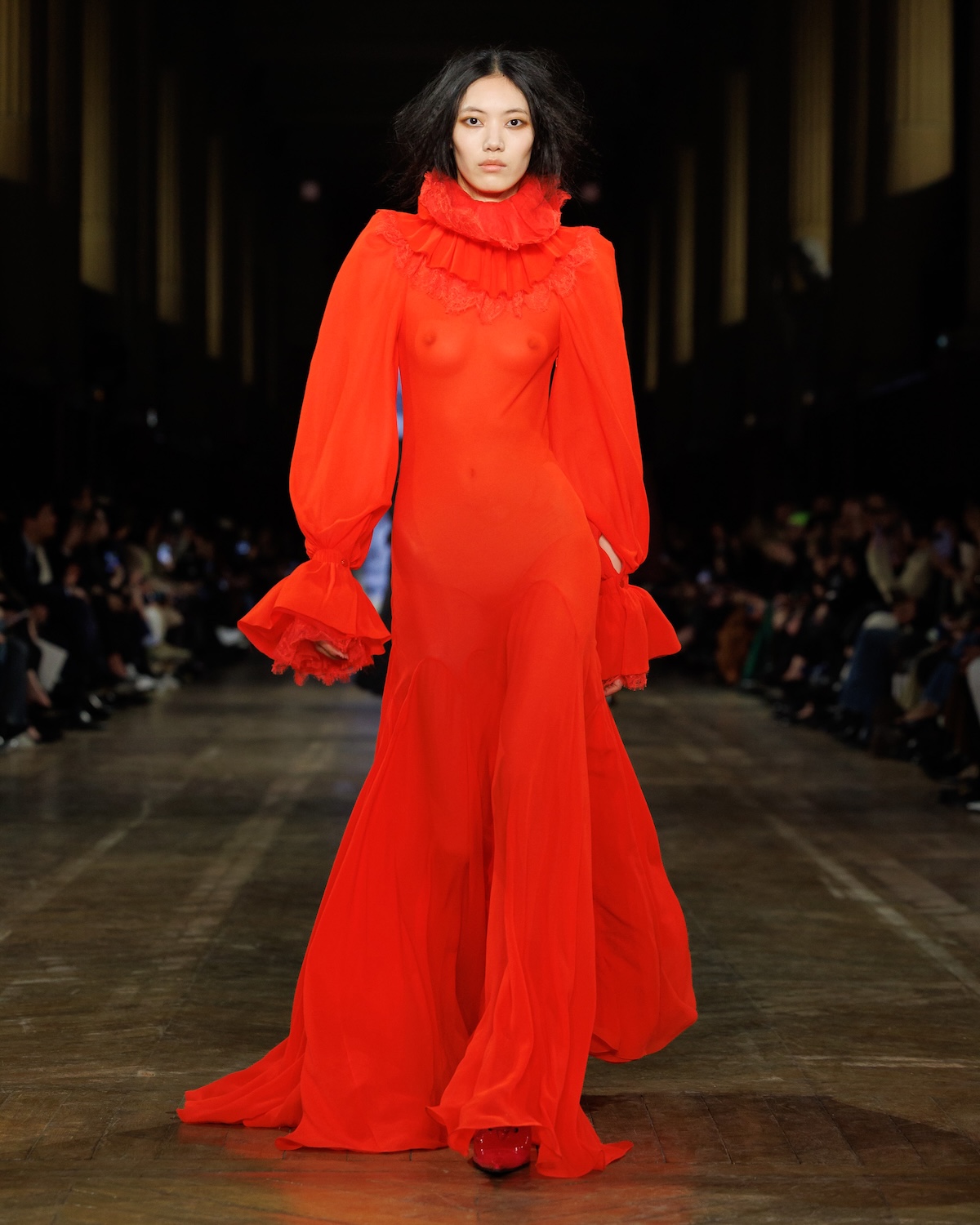
During his tenure at McQueen thus far, Irish designer Seán McGirr has largely found inspiration on the streets of London – his adopted home city where he arrived to study at Central Saint Martins in the early 2010s. This season, in a more intimate presentation, his third collection for the British house, he said post-show that he was thinking about ‘Victorian London… particularly Charles Dickens’ Night Walks, conjuring a nocturnal dandy ‘who walks on the streets until dawn’. Historical inflections came in raised ruffled collars, capes and carved waistlines, while extreme elongated footwear – recalling the shape of a winklepicker – lent a strangeness to the silhouette. In a continuation of the crystallised finale looks of last season, the collection was heavy on embellishment, from bejewelled facemarks to scores of surface adornment on leather jackets and dresses, or the gilded embroidery on the frock coat which closed the show.
Another reference was Oscar Wilde, a writer McGirr said he grew up with as a teenager and who is synonymous with the figure of the dandy. ‘To me, dandyism is the ultimate act of adornment; deeply personal, playful and transgressive. It raises questions of character and identity, idealism and gender,’ said McGirr. ‘I wanted to explore the enduring relevance of the dandy’s radical spirit in our modern world.’ In this translation of past to present, McGirr also spent more time in the McQueen archive this season, paying particular attention to Lee McQueen’s hourglass-shaped tailoring. ‘McQueen is all about the waist… I wanted to rework [that] in a way that made sense for today.’ JM
Comme des Garçons
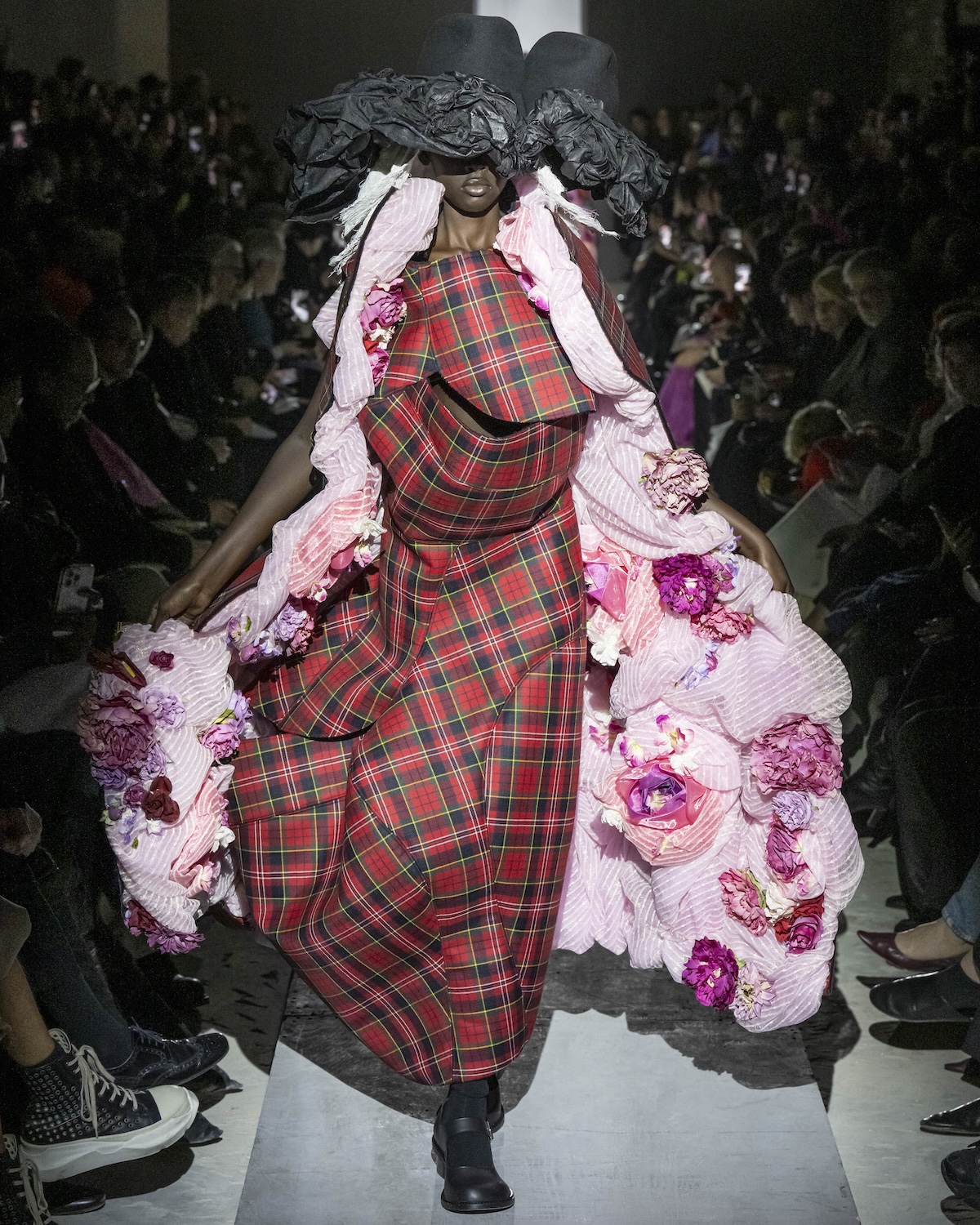
Rei Kawakubo’s latest runway show was a declaration of independence. ‘Recently we feel that big business, big culture, global systems, world structures maybe are not so great after all,’ she issued in a brief statement on her A/W 2025 show, presented in Paris on Saturday afternoon. ‘There is also strong value in small. Small can be mighty.’ She is proof: now over half a century since she founded the convention-defying label in Tokyo, Japan in 1973, Comme des Garçons provides alternative to the luxury fashion conglomerate, shepherding a small umbrella of designers (among them Junya Watanabe and Noir Kei Ninomiya) and incubating several more (the designers behind Vaquera, one of those labels, were in attendance at the show). As such, the collection’s opening felt like a send up of the corporate uniform: tailoring fabrics, from Prince of Wales check to pinstripes, were reimagined into Kawakubo’s strange, undulating forms. That off her chest, the rest of the collection looked towards tropes of femininity, from ruffles, pleats and floral motifs (the latter as a 3D adornment on the inside of a tartan dress, which the model held open as she walked) to textures of velvet and satin. As ever, it was a free association of ideas from a designer who, at 82 years old, remains one of fashion’s most liberated – and independent – voices. JM
Hermès

Upon entering the low-lit Hermès space, the feeling underfoot was like stepping onto a particularly plush material – though, as your eyes adjusted, the spiralling runway was actually covered in a soft layer of soil. It set the stage for a ‘determined’ collection from Nadège Vanhée, who in lieu of thematics described the collection’s mood as ‘sculptural, resilient, seductive… [the woman] moves forward, never looks back. She has everything she needs.’ So out stomped her largely leather-clad cast in riding boots and high-heeled brogues, the latter’s perforations also appearing as leather piping on sculpted dresses and mini shorts. Leather was a focus throughout – an expression of the house’s extraordinary command of the material – from enveloping reversible overcoats to a stripped-back riff on the biker jacket and pin-sharp tailoring, or the sensual line of a ribbed wool and leather dress. In its movement between the everyday – albeit reimagined in hyper-luxurious style – and a pulsing undercurrent of sensuality, it was the latest chapter in Vanhée’s ongoing interrogation of womanhood at the house. Now in her tenth year, it is a vision that looks more desirable than ever. JM
Andreas Kronthaler for Vivienne Westwood
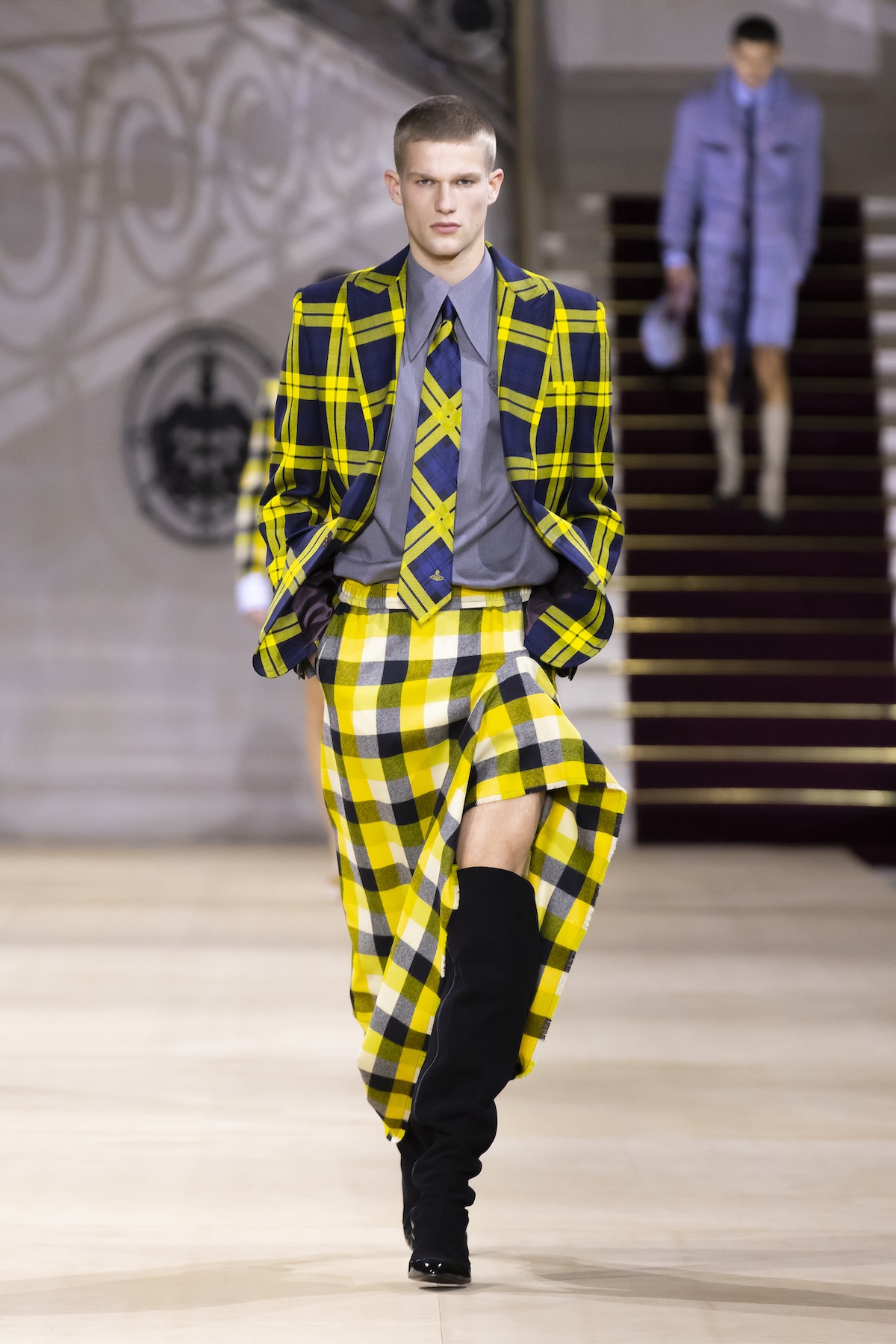
Andreas Kronthaler was feeling sentimental this season. ‘This collection is about honouring the place I have lived for more than 30 years: London,’ he said ahead of his A/W 2025 show, which – if not a touch ironically – was held in Paris yesterday afternoon. His ode to the city began with the anchors of every Westwood collection – knitwear and tailoring – which the designer subverted through a series of witty, swashbuckling silhouettes that channelled the distinctive creative language he shared with his late partner, Vivienne Westwood, for three decades.
Heritage fabrics were pushed to new realms of invention, so that Harris tweeds came in a carnival of shades and stripes, deep blue Yorkshire wools were transformed into fuzzy bodysuits, and bolshy Scottish tartans appeared in Clueless-esque wonky suiting. Ties, meanwhile, were so exaggeratedly long they skimmed the knees. Elsewhere, a love letter to Westwood’s style of drape, cut and corsetry ran through the designer’s more feminine looks, where cowl necks and boning exposed bare chests, and silhouettes roved between Victorian to Grecian and bohemian.
Drawing inspiration from a lengthy list of figures the brand admires – among them Quentin Crisp, Gertrude Stein and Rihanna – the result was a collection that unified a hodge-podge of characters and sensibilities. Not unlike the subcultural melting pot of London itself, Kronthaler’s school of A/W 2025 was a place where an office-punk, windswept chiffon goddess, padded 1980s ski instructor, and a bodiced gothic bride (who closed out the show) could happily coexist. ‘Vivienne taught me the love of tailoring and knitting,’ said Kronthaler. ‘The formality it gives you is a framework to express yourself. There’s nothing sexier than a suit.’ OB
Noir Kei Ninomiya
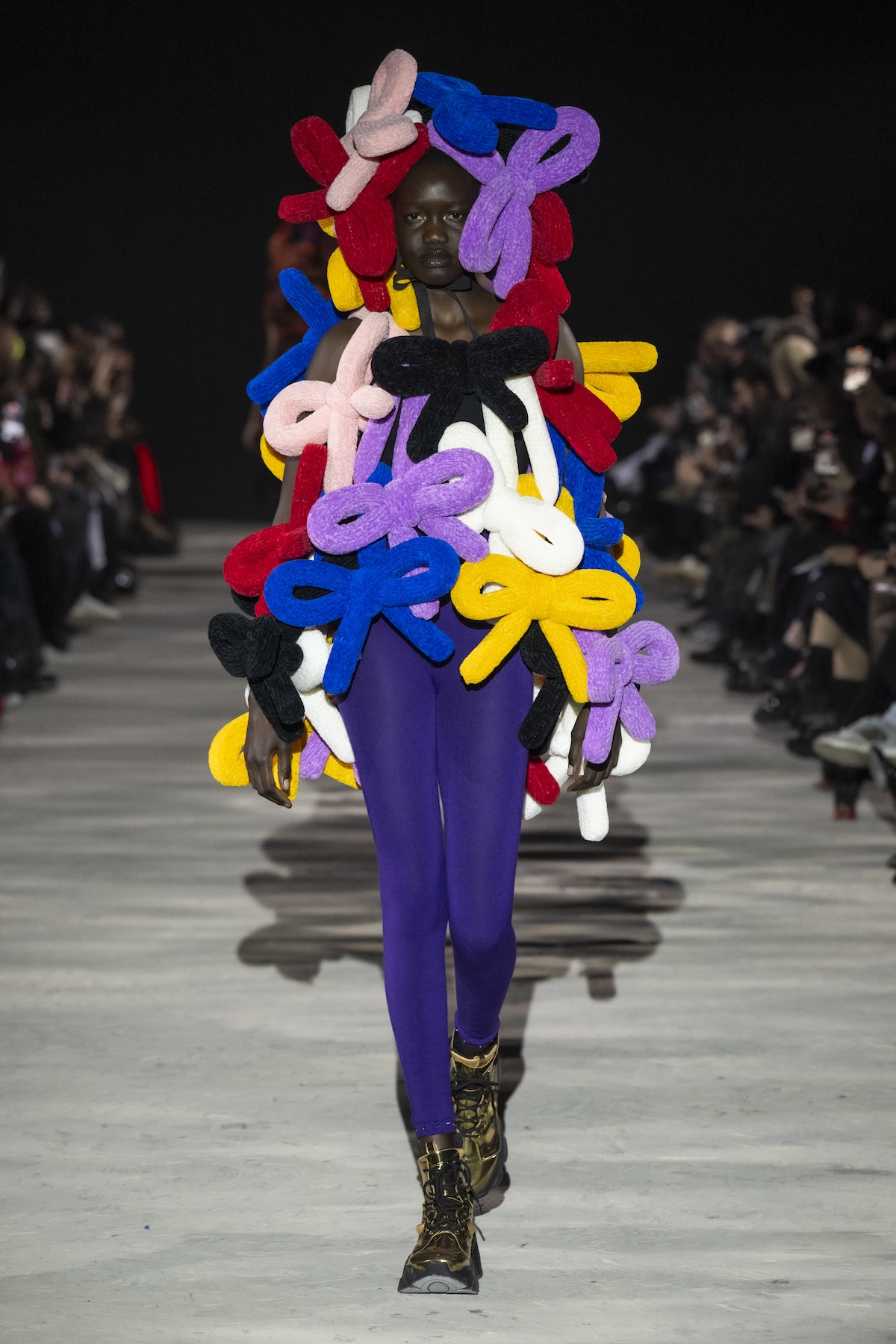
Until 2019, Noir Kei Ninomiya showed his raven black collections in stark white rooms – just natural light, no music – with the idea that others could see the clothes ‘deeply and simply’. Things have changed quite substantially since then. Yesterday morning, guests of the Comme des Garçons designer’s A/W 2025 show were welcomed into a darkened space that was lit solely by the glow of UV, illuminating the outfits of the oft-too serious front row like dancers in a neon rave.
The collection that followed was, as ever with Kei Ninomiya, an expression of unrestrained invention. Soundtracked to glitchy electronica, the opening looks had the colour and cheer of a kindergarten crafts room; bulbous plastic shapes resembled squishable toys in gashapon vending machines, an assemblage dress of massive bows had the texture of multi-coloured pipe cleaners, and dozens of yarn pom poms were adjoined into a modish ultra-mini dress topped with a mushroom stool matching hat. Designing from impulse rather than reference, the designer summed up the collection in a typically mysterious fashion – ‘a kind of feeling that is uncertain and hard to understand.’
While the Japanese designer has, in recent years, introduced a more vivid palette, his most enduring fascination remains in the language of black – as reflected in the closing looks of his A/W 2025 collection. Showcasing his gift for adorning the body in unconventional materials ‘to achieve expressions impossible with just fabric‘, this time resin was the star of these monochromatic creations. Taking on alien proportions, balls of shimmering fronds exploded from the body, while inky tailoring saw spines of spiky white plastic that glowed under the UV sprout and spiral from jackets. It made for a spectacle of sensory overload that only Kei Ninomiya could have produced. ‘Black is just the word, but it really has a meaning, very strong and very beautiful, and very deep,’ he once said of the beloved shade. ‘It has such a feeling.’ OB
Junya Watanabe
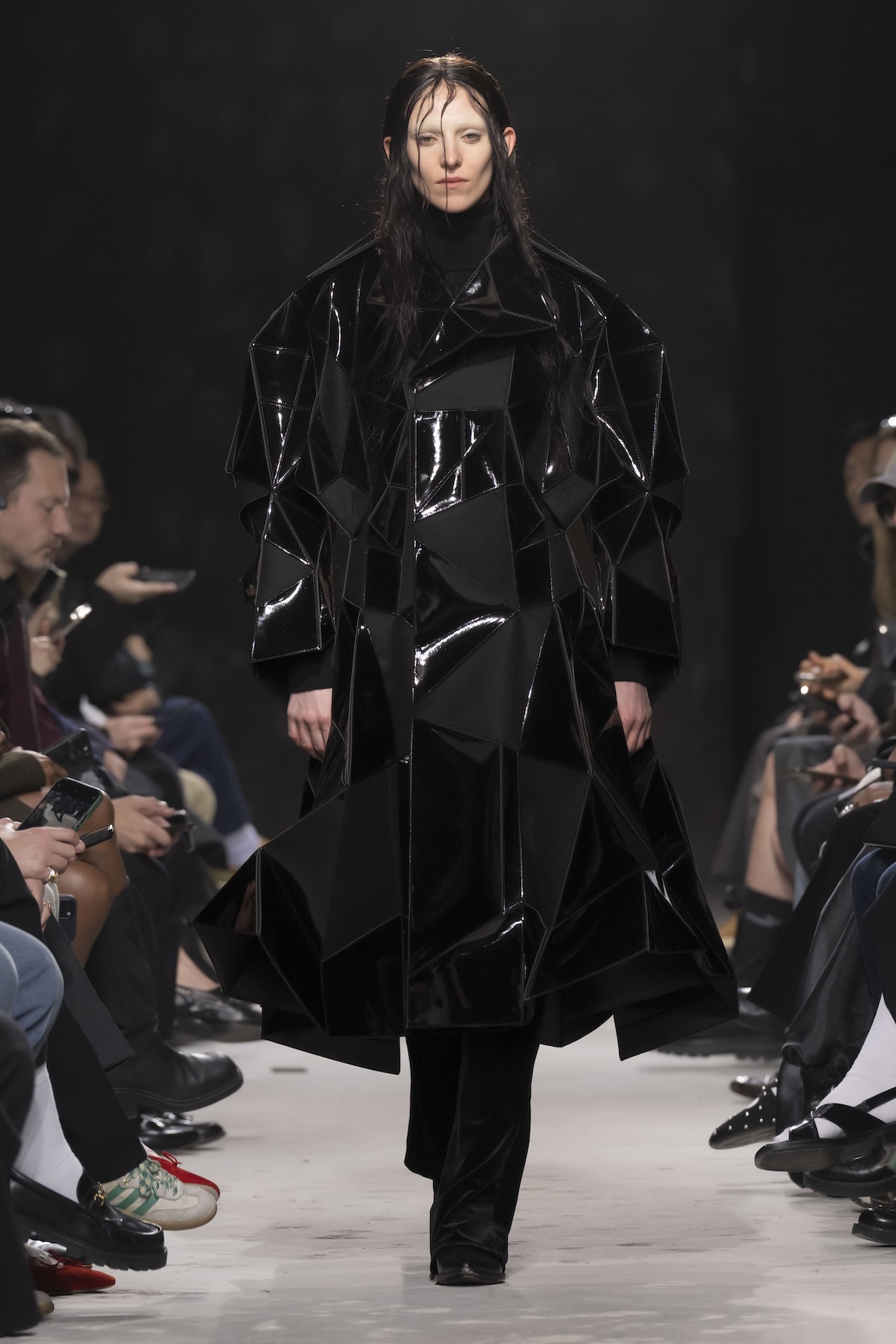
After a rugged Junya Watanabe MAN show earlier this year – which largely riffed on tropes of classic American sportswear – the Japanese designer was back to a more experimental mood for his latest womenswear outing, shown in a stripped out former shop on Paris’ Rue Auber. ‘I'm fascinated by creating clothing that appears to be unrealistic. This time, I created everyday clothing from a cubist perspective,’ he elucidated, explaining the collection’s protruding spikes or sharp, geometric surfaces, which transformed pieces like the leather biker jacket or trench coats into surreal – but undeniably Watanabe-esque – forms. Others had enormous pitched shoulders, or became strange hybrids, like a pair of lace-up leather boots which became the sleeve of a jacket. Another inspiration was the musician Jimi Hendrix, which lent the collection a rock and roll inflection, from amped-up fuzzy jackets and shades to python-print pants and garments crafted from hair and wigs. JM
Victoria Beckham
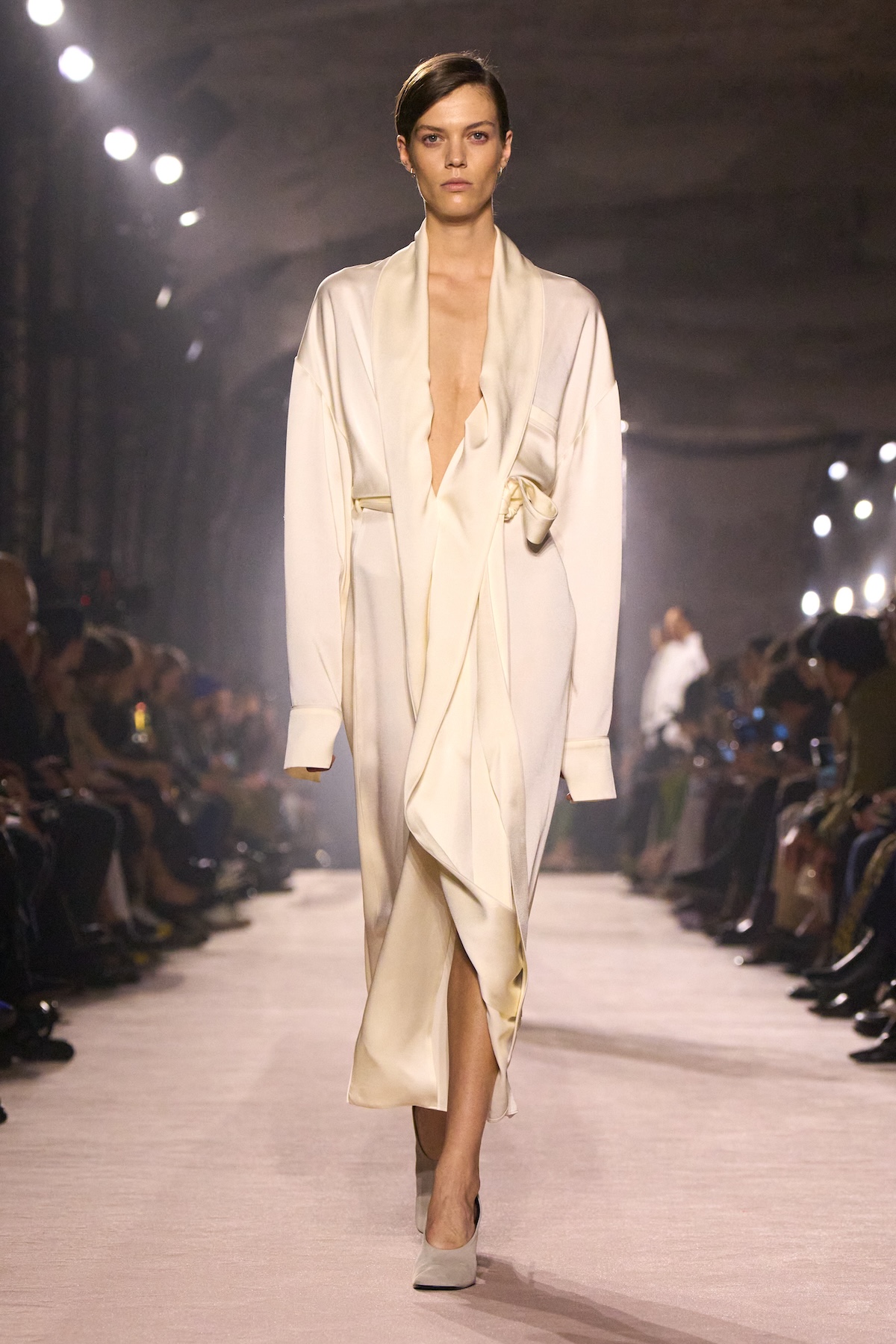
This season, Victoria Beckham found inspiration close to home – within the four walls of her own dressing room, to be precise. Unveiled in a stark runway space in Paris yesterday evening to a sultry soundtrack that moved between jazz and trip hop, her A/W 2025 show was about the ‘tricks’ and ‘happy accidents’ that shape the way we put on clothes every day. Doubling down on the flattering cuts that are the backbone of her brand, the resulting collection roved freely between dress codes, as if pulled instinctively from every rail of the wardrobe. Raincoats and parkas were exaggerated or cropped, exposing body-hugging garments that took cues from the knicker drawer. Elsewhere, Beckham played with the ways women might borrow their boyfriend’s clothes and adapt them, so that masculine shirting was rolled up at the sleeve and oversized trousers were cinched at the midriff. Winking at the make-up tutorials she films at home, silk dressing gowns were reconstructed into lustrous evening dresses, while the designer’s initial-emblazoned bathrobe was slashed into pussy-bowed smoking jackets in terry-cloth towelling. It was a love letter to spur-of-the-moment dressing that was firmly rooted in Beckham’s own personal language of chic – clothes that she and the brand’s customer have worn, and will wear, time and again. OB
Issey Miyake
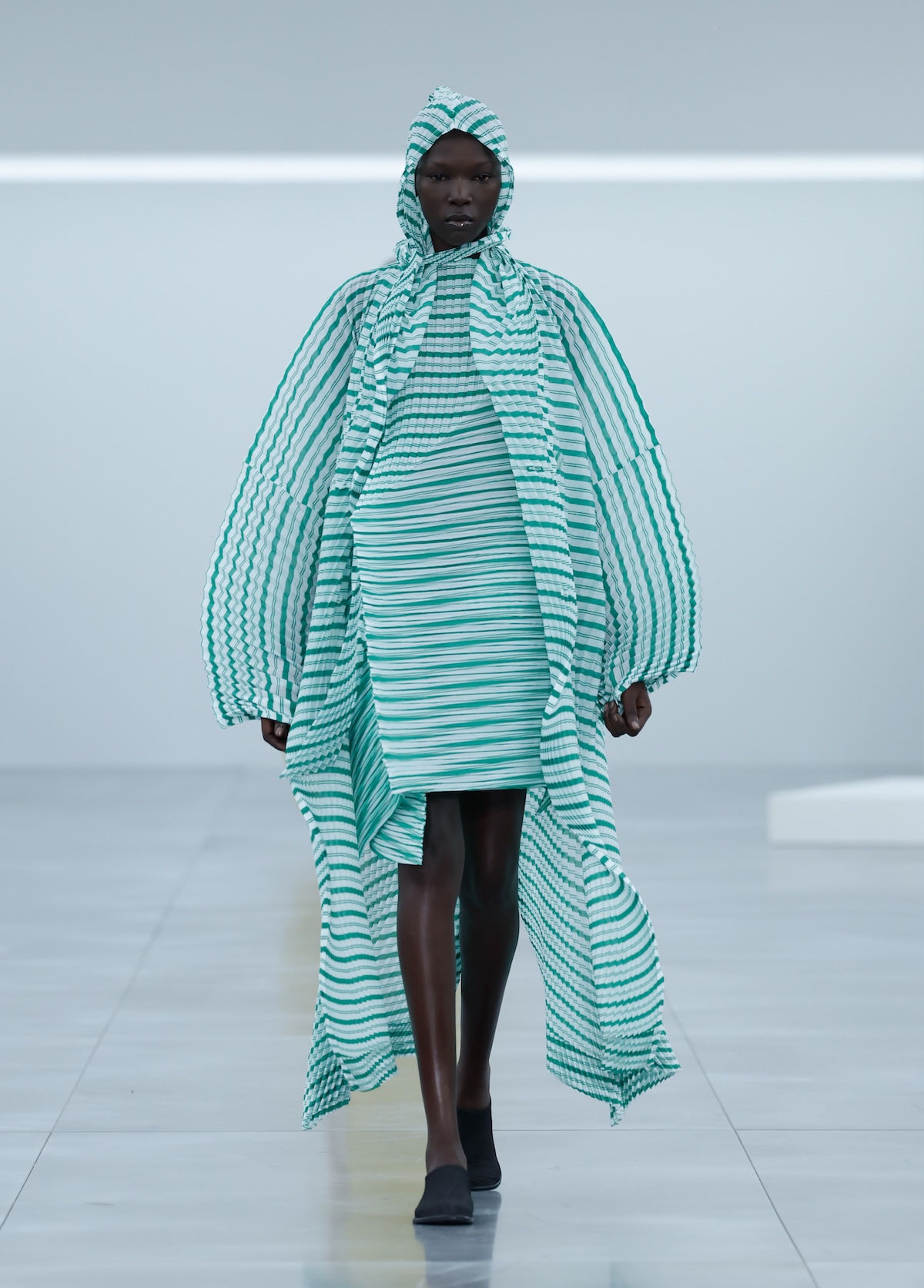
Since the late 1980s, Austrian artist Erwin Wurm has invited members of the public to hold specific objects – from plastic buckets and chairs to stacks of oranges – for a minute or so (Wurm discourages specificity on timings). A practice the artist has returned to over the decades, Wurm’s ‘One Minute Sculptures’ see the ‘participating viewer become part of the sculpture for an ephemeral time,’ as a blurb on the artist’s website describes. On Friday afternoon in Paris, Wurm staged his latest edition of ‘One Minute Sculptures’ as the backdrop to Issey Miyake’s A/W 2025 runway show. Held at the Carrousel du Louvre, a group of performers were invited to interact with Issey Miyake garments, stretching them into strange, body-like forms for the duration of the show – an apt reflection of the playful spirit of the Japanese label, which has long been fascinated by fabric and form.
The collection itself was titled ‘[N]either [N]or’, seeing head designer Satoshi Kondo look towards the ‘ambiguity and many in-betweens’ of Wurm’s project for a collection that was rooted in the ‘freedom of wearing [clothing] in one’s own way and the exciting possibilities that are yet to be discovered within the garments’. As a result, there was a spirit of play in Kondo’s clothes – trompe l’oeil prints of Issey Miyake knitwear ran along undulating plissé gowns, blown-up paper bags became colourful strappy tops, and clever new heat-pressed knits made structured, paper doll-like silhouettes. A liberated use of colour, evocative of Wurm’s photographs, ran throughout.
It was a collection that continued Kondo’s recent winning streak. His garments have the illusion of spontaneity, though they are actually the result of several months – even years – of fabric experimentation and craft. ‘Issey Miyake was tenacious and stubborn. It’s something that echoes with me, too – that tenacity, that perseverance,’ Kondo told Wallpaper* in the recent March 2025 Style Issue. ‘He continued until he found something really original. It’s a mindset. When you want a really beautiful flower, you don’t go to the florist, you go out into the forest.’ JM
Givenchy
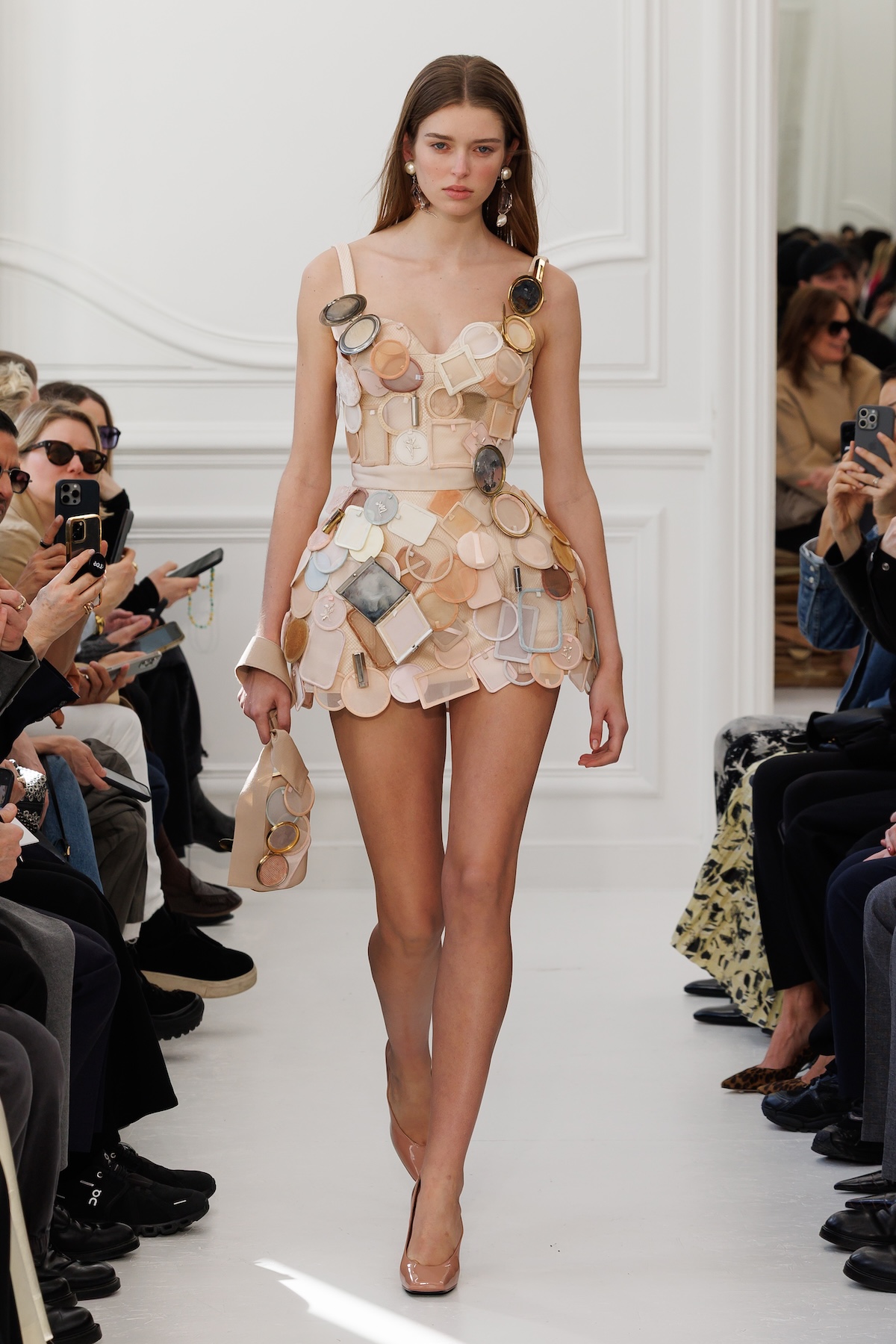
Sarah Burton’s first collection for Givenchy began with the discovery of a cache of pattern pieces, stuffed in brown envelopes and hidden behind a wall at the former Givenchy maison at 8 Avenue de Vigny, found during a recent renovation. Created by Hubert de Givenchy, they date back to 1952, the year he founded the eponymous house. For the former Alexander McQueen designer – who is known for a meticulous hand when it comes to cut and make – they sparked the exploration of contemporary womanhood which unfolded at the Givenchy salon on Avenue Georges V on Friday morning. ‘It’s my natural instinct to go back to pattern-cutting, to craftsmanship,’ she explained, noting that each garment was fitted at least three times on the body before walking the runway. ‘To cut, shape and proportion. It’s what I feel, how I work, and want to do.’
It led to a collection that eschewed theatrics for clarity and purpose, though not without flourishes of glamour and romance. ‘I want to address everything about modern women,’ she said. ‘Strength, vulnerability, emotional intelligence, feeling powerful or very sexy. All of it.’ So there was precise tailoring, carved narrow at the waist and wide at the shoulder (edges were left raw as if to suggest an act of construction), trapeze-shaped overcoats, and roomy leather shirts and jackets, while eveningwear moved from intricately embroidered opera coats tied with enormous obi-style bows towards bouncing layers of lemon yellow tulle, flared ballet skirts and tuxedo-inspired tailoring, sliced at the waist or turned back to front. Meanwhile, in splashes of the surreal, tops and dresses were constructed from make-up powder cases and tangles of jewellery.
It was a strong start which, despite its sheen of modernity, was nonetheless rooted in Hubert de Givenchy’s archival designs. In the sunlit salon – which is also the historic site of the house’s couture atelier – the intimate guest list perched on symbolic piles of pattern pieces, like those discovered hidden on Avenue de Vigny. ‘To go forward, you have to go back to the beginning,’ Burton said. ‘To me, that’s about the atelier. It’s the heart and soul of Givenchy.’ JM
Chloé
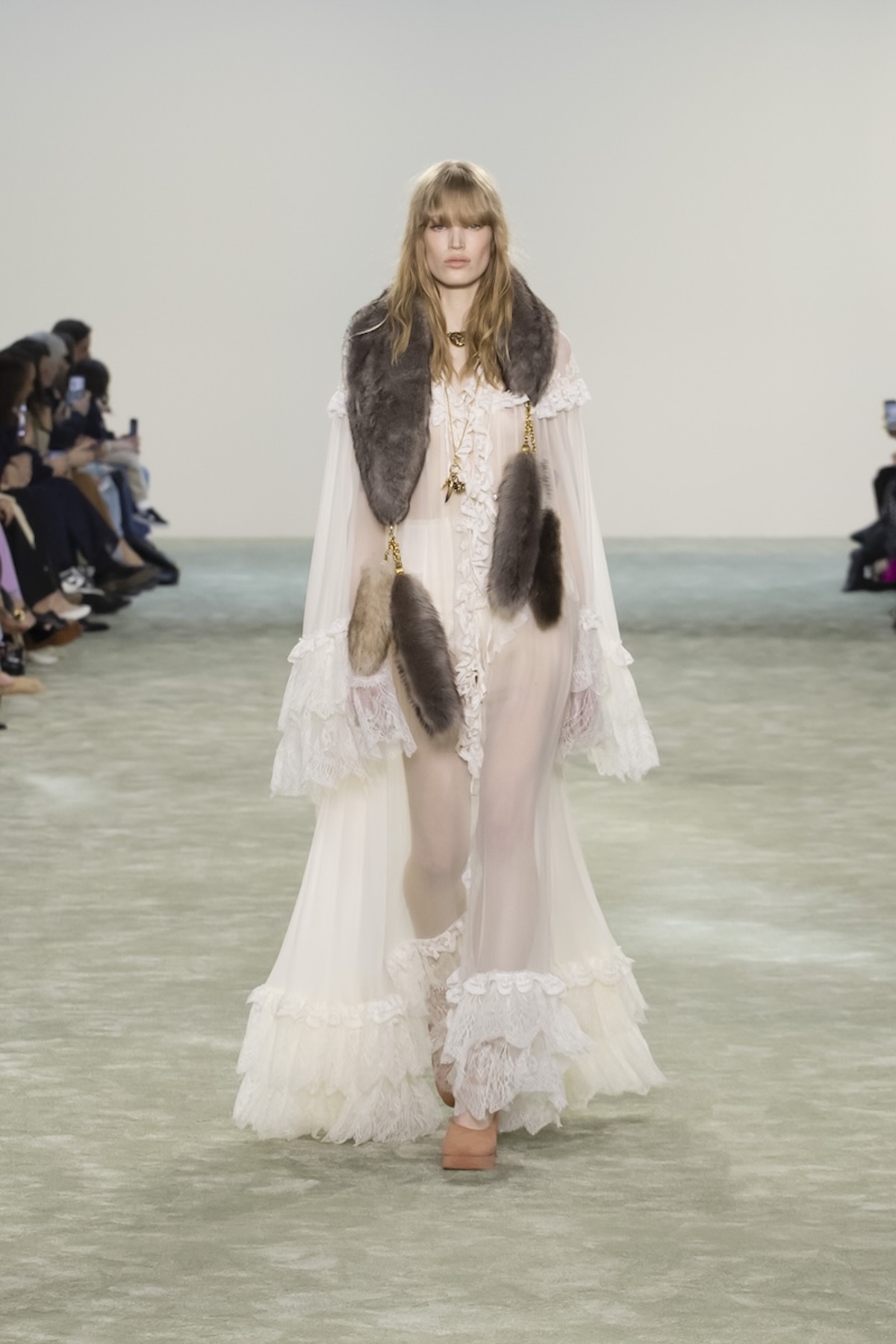
Chemena Kamali continued to hone her breezy, bohemian vision for Chloé – one that recalls Karl Lagerfeld’s free-spirited early collections for the French house – though this season, the German designer talked about seeking ‘evolution… to redefine and to evolve the Chloé woman’s state of mind’. There was certainly a more opulent feel to the collection, which borrowed from bourgeois dress codes – namely a proliferation of ‘fur’ (like most designers this season, it was actually shearling with the illusion of fur), whether as nipped, patchworked jackets, trims or stoles, while heritage overcoats, ladylike chain handbags and Mary Jane footwear struck a similar mood.
They were welcome additions to the Chloé uniform, which this season felt more grounded in everyday wear – Kamali talked about a finding mood of ‘realness and instinctive ease’ in flared jeans and leather trousers, as well as the eclectic, thrown-on styling. That said, there was still fun to be had in the romantic gowns in the millefeuille ruffles of taffeta and lace which have become the designer’s signature. ‘I thought about how we romanticise the past through an intuitive lens, blending traces of tradition and historical fragments, pieces passed down through generations, what we once loved with what we love today,’ she described. JM
Rabanne
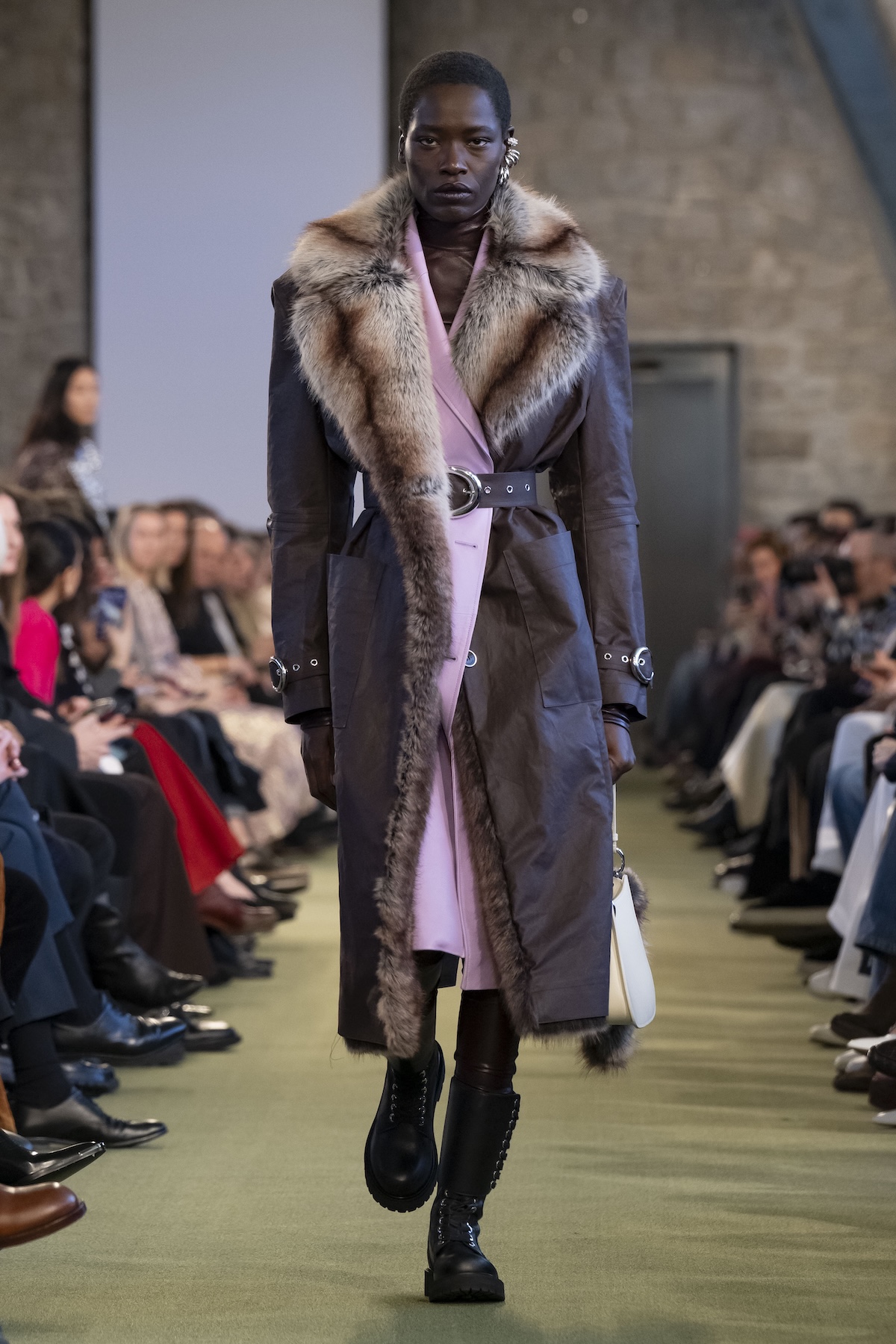
It is astounding how fur – albeit in faux or shearling iterations – has dominated this season’s runways, emerging time and again across the four major cities. No doubt it speaks to our desire for protection against the elements, both real and existential – an idea that will surely be unpacked by commentators in the coming weeks. It was at Rabanne Julien Dossena conjured some of the most arresting ‘furs’ of the month so far, spanning knit gowns with tassel-like ‘tails’ around the hem, sliced shearling skirts and tabard tops, and bombastic fur coats lined with shimmering, tinsel-like fabric – at once glamorous and primitive. Dossena called the juxtaposition one of preciousness and protection: opposing impulses which also met in clear plastic raincoats worn over gleaming chainmail dresses, or the hardy, outdoorsy wools and leathers clashed with delicate beadwork or sequins. These tonal shifts were intriguing and beautiful, confirming Dossena’s status as one of Paris’s most consistently impressive designers. With another stellar collection under his belt – and having served over a decade at Rabanne – the question lingers: will Dossena be one of fashion’s next big moves? JM
Rick Owens
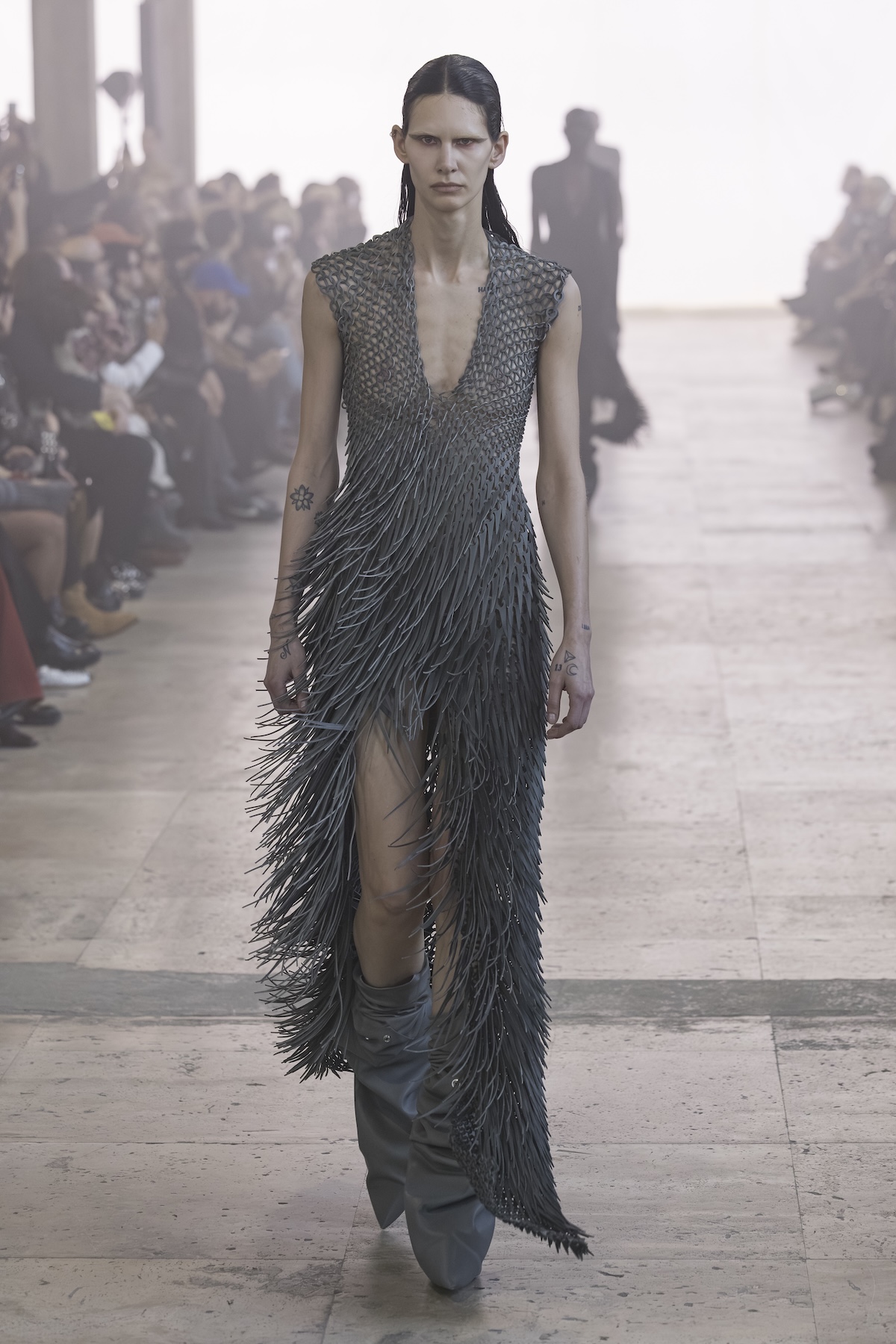
Held in one of the vast interior wings of Paris’s Palais de Tokyo – a longtime show location for the designer – Rick Owens called his latest womenswear collection ‘Concordians’, the same title as his menswear show held earlier this year. It references the industrial Italian town of Concordia, just outside Venice, where Owens produces the bulk of his collections each season.
Having travelled there for over two decades (in various dwellings, from a couch in his office to a ‘serial killer hotel’ and now his own apartment), the town’s relative banality has become a part of his and his team’s creative rhythm: ‘a studious isolation… almost bleakness. This cloistered life seems to be what it takes to be able to focus on reaching for something weird and wonderful.’
The spoils of that isolation were on show here in a collection which channelled a subversive, Owensian glamour: whether the ‘chain-linked’ laser-cut leather dresses which appeared on the body like scales or feathers (a collaboration with Parisian designer Victor Clavelly), towering, broad-shouldered overcoats in wool or leather, or, in another continuation of the menswear show earlier this year, ‘megacrust’ denim, whereby the fabric is intricately layered with bronze foil and wax. ‘I want to depend on fewer things but make them as supernatural as possible,’ he said after the menswear show, and here he seemed to retain that focus – this was a collection which was undeniably Rick Owens, though here evolved through extraordinary craft and make.
Iggy Pop’s ‘Mass Production’, which soundtracked his very first show 23 years ago, made a nostalgic return – another suggestion that Owens was digging deeper into his label’s rebellious roots. ‘We won’t legally be able to use it on YouTube,’ the designer said, ‘but it’s a song that yearns for the weird and wonderful, as much to me now as it did back then.’ JM
Schiaparelli
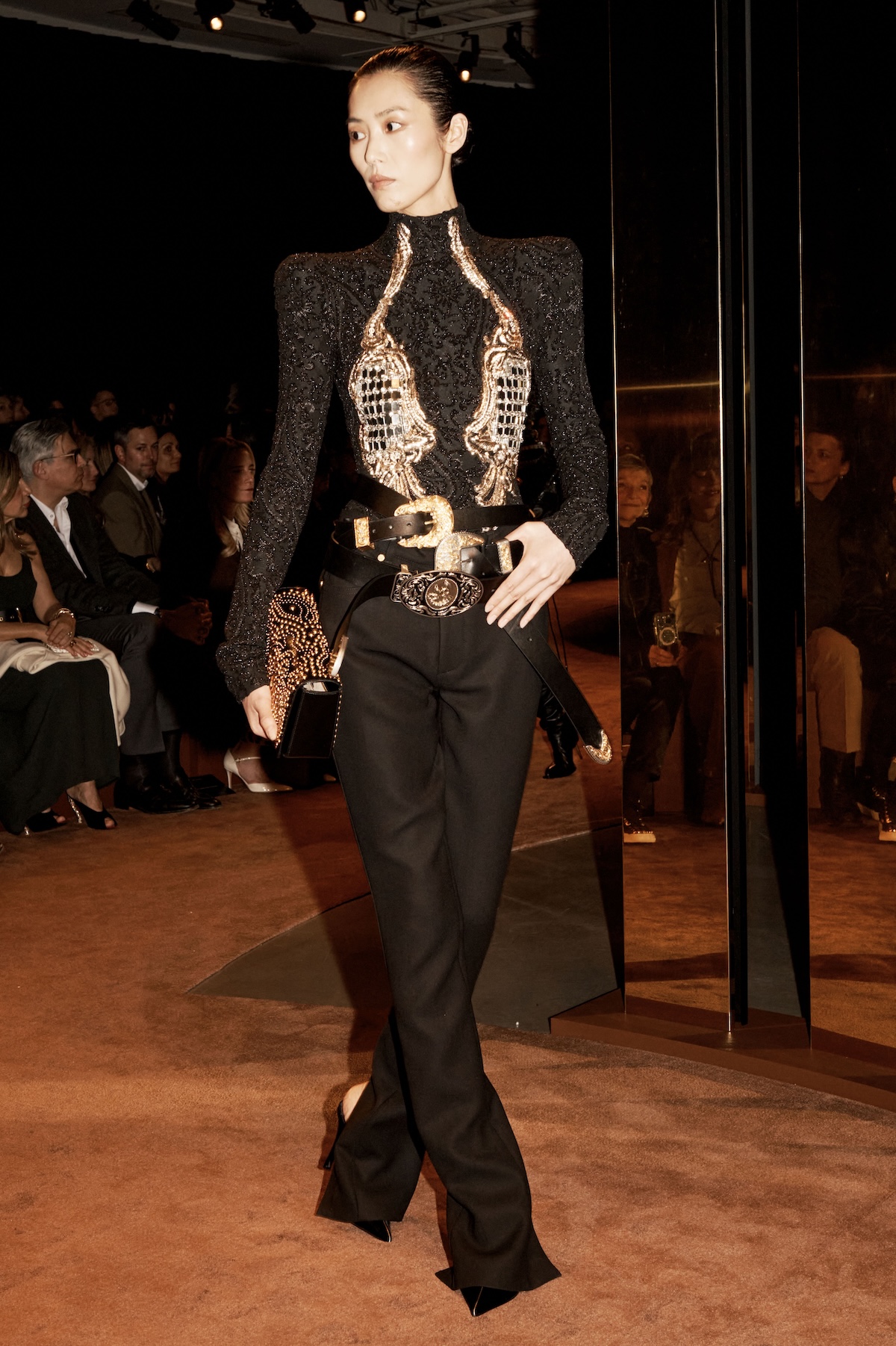
What would the world be like if we woke up tomorrow and there were no men? How would women dress? These musings are usually the stuff of playful debate over the dinner table, though yesterday in Paris, Daniel Roseberry brought them to life with a high-glamour A/W 2025 collection for Schiaparelli. Observing ‘that the women I know rarely, if ever, dress for men… when they do dress up, it’s for other women, and it’s women’s praise that matters to them,’ the American designer imagined how women would remember masculine archetypes in an alternate reality where they ‘inherited the earth’.
The resulting collection, which Roseberry titled Lone Star, pulled from his fantastical couture offering in January, as well as old Hollywood tailoring and gunslinging Western tropes that paid tribute to his upbringing in Texas. Balancing ideas of dominance and tenderness, his women appeared in decadent velvets, voluminous furs and sheeny satins in silhouettes that played with juxtapositions: feline second-skin dresses, demure oversized 1940s suiting and spangled cinched-waist drama fit for the red carpet. Southern charm came in waves of bow-legged denim, leather fringing, cowboy boots and low-slung belts that were accentuated through the house’s gilded codes. It was, he says, a tribute to the strong women in his life.
‘In this post-social media era – when many of us have become weary of and disgusted by living our lives through the screen – many of us are asking what makes life meaningful,’ Roseberry said in a letter to attendees. ‘I’ve spent the past few months speaking less and listening more. I wanted to make things that can inspire. The women in my life are lone stars – there’s no one else like them, and there could never be. I hope they, and all women, feel the same about these clothes.’ OB
Tom Ford
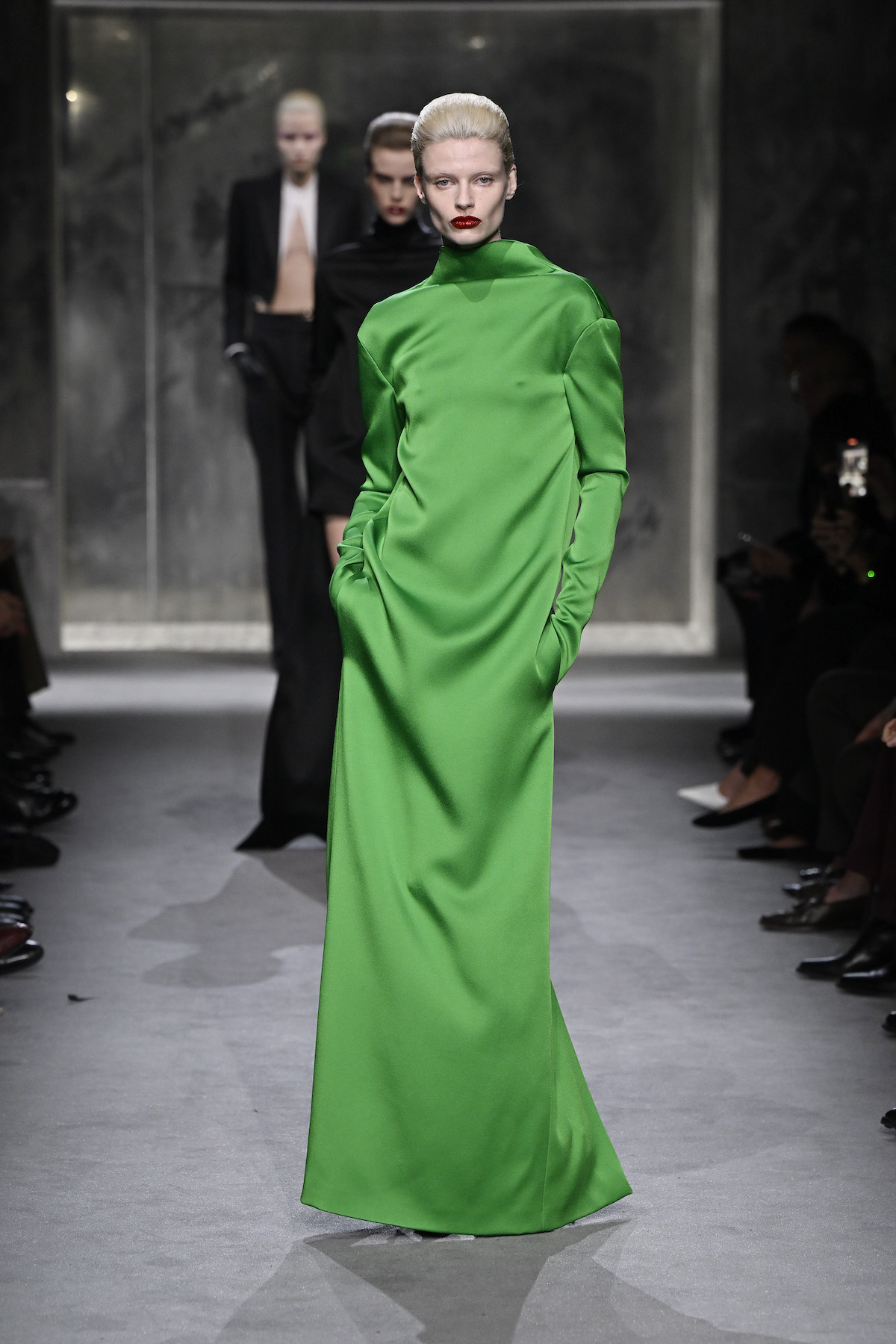
Haider Ackermann made a confident start to his tenure at Tom Ford, which he described as an attempt to capture the mood of seduction which he sees as foundational to the label. ‘I hope I seduced you all,’ the designer said backstage after the show, which instilled the uninhibited glamour synonymous with the label – founded in 2005, just after the eponymous designer’s departure from Gucci – with something more louche and darkly romantic, a hallmark of Ackermann’s own work at both his now-shuttered label and Berluti, where he was briefly creative director. Comprising both men’s and womenswear, the collection deftly shifted between daywear – largely in leather and largely black – towards showstopping eveningwear in the bold, painterly hues with which Ackermann has become synonymous. A sinuous yellow gown was hiked up above the hip on one side, another came in striking green satin sliced seductively along its back (a particularly Haider-esque gesture), while a lilac dress was adorned with shimmering tassels. For men, tailoring was pin-sharp, with smatterings of sparkle a nod to the more overt glamour elsewhere. It ended with a standing ovation – the intimate show was packed with Ackermann’s friends and well-wishers – while Tom Ford himself gave a seal of approval with a warm embrace at the show’s close. JM
Acne Studios
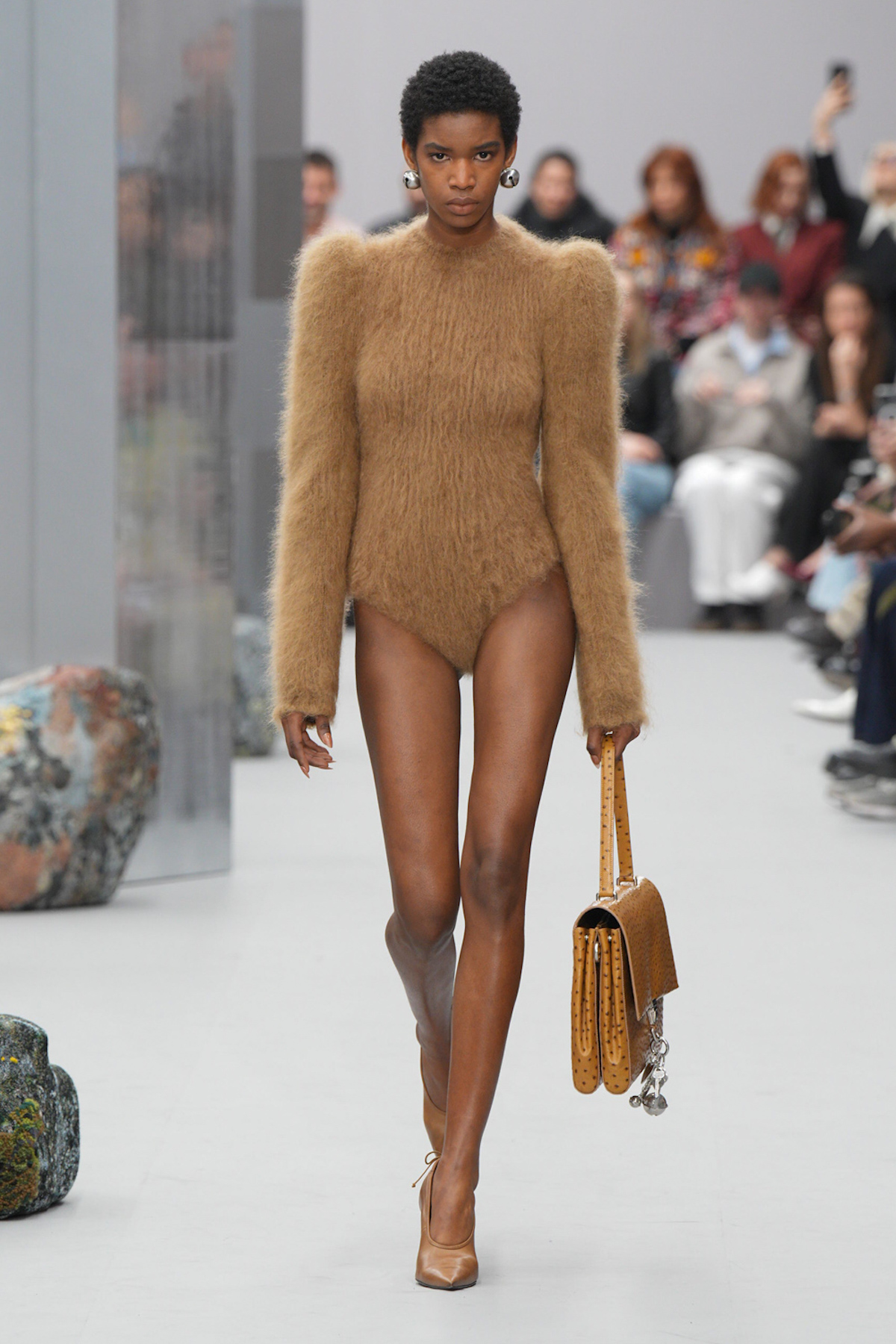
Acne Studios latest collection played out amid a surreal skyline conceived by the set designer Polly Philp, whereby totemic metal ‘skyscrapers’ were interspersed with tapestry-covered ‘rocks’ by design duo Front, inspired by the natural landscapes of Sweden. This clash, between nature and the city, provided the impetus of Jonny Johansson’s latest collection, which saw the designer imagine his protagonist wandering from the windswept Nordic north and into an urban cityscape for ‘a dynamic juxtaposition of two worlds; an exercise in contrasts.’ As such, garments which suggested an overt glamour – like a power-shouldered body suit – were imagined in soft, teddy-bear like fabrics. Indeed the bear, inspired by a rewatch of Björk’s Human Behaviour video (the musician had ‘curated’ a newly mixed version for the soundtrack), became a trope, with the construction of a teddy bear’s limbs inspiring the blown-up proportions of tailoring and outerwear, as well as an enormous paw-like boot.
Alongside were pieces which conjured the surreal femininity Johansson has been honing in recent seasons – a dress covered in trailing ribbons and bows, crinkled leather pussybow shirts, hazy trompe l’oeil prints – while a sense of the homespun recalled the designer’s own roots in northern Sweden. ‘A Nordic upbringing develops a deep connection to nature. Nature and urban cities have always had a relation that fascinates me,’ he said. ‘It is the tension and contrast between the two of them that I have tried to portray within this collection.’ JM
READ: Acne Studios has created a surreal skyline for its A/W 2025 runway show
Stella McCartney
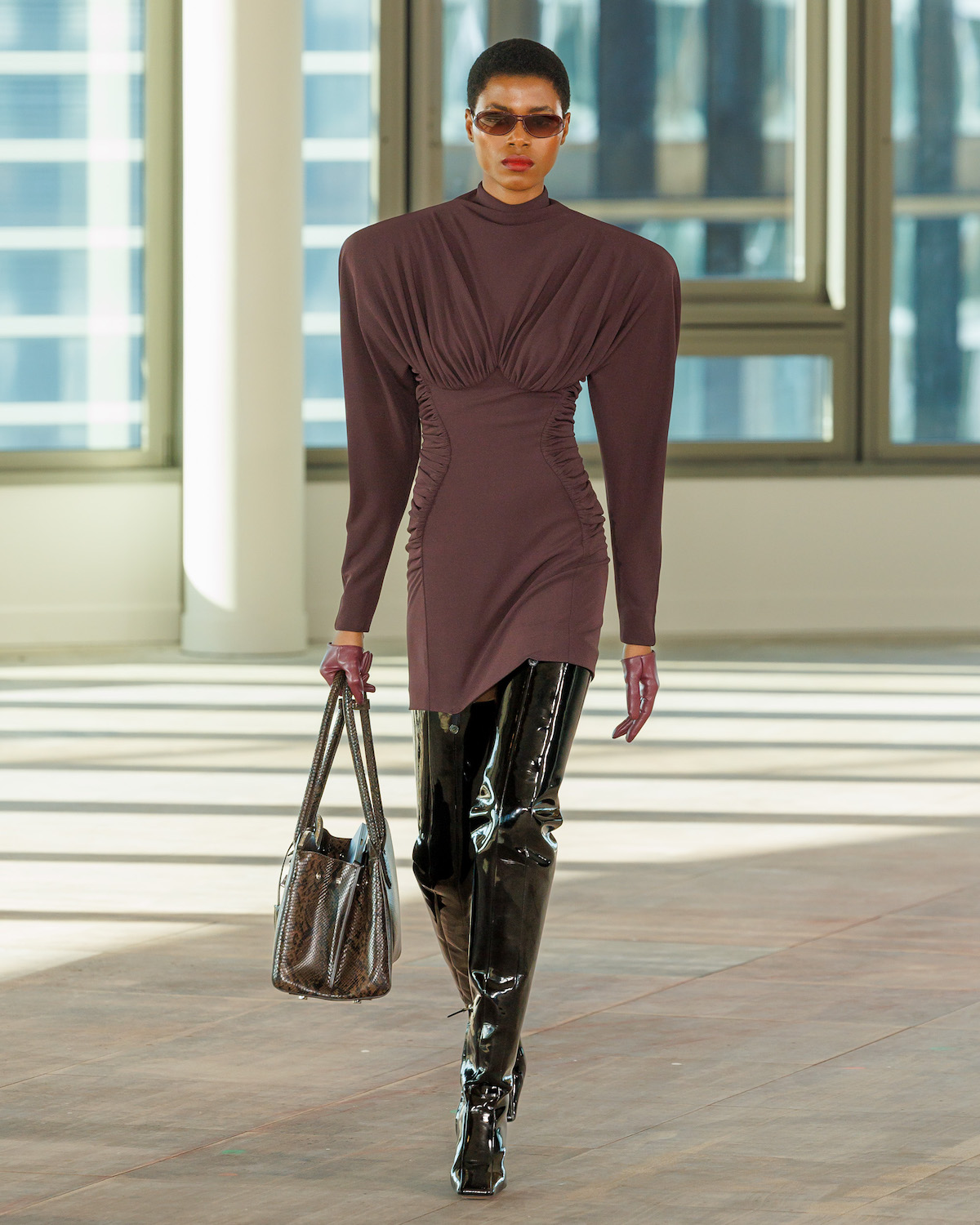
Stella McCartney was in a playful mood this season, holding her runway show in the surreal ‘Stellacorp’ headquarters, a simulacrum of a corporate office complete with spinning chairs and computer desks. Even more surreal were the handful of male and female pole dancers who emerged at the show’s finale, a nod to the collection’s title, which was ‘Laptop to Lapdance’. ‘A bold day-to-night wardrobe for the working woman,’ described McCartney of the collection’s roots, which saw her imagine the season’s protagonist heading from a day in the office to a night out on the town in typically irreverent fashion. Part Working Girl – power shoulders were a definite feature – the collection swayed between double-breasted tailoring, pencil skirts and office blouses (worn with a hefty dose of irony), and party wear, from tasseled jeans to T-shirts which read ‘Slippery When Wet’. And, while it made for a moment of much-needed escapism, McCartney remained fastidious about sustainability, with 96 per cent of the collection crafted from conscious materials (and, as ever, 100 per cent cruelty free). This included some impressive versions of python and ostrich skin, here crafted from the innovative Yatay M, an alternative leather made from mycelium. JM
Dries Van Noten
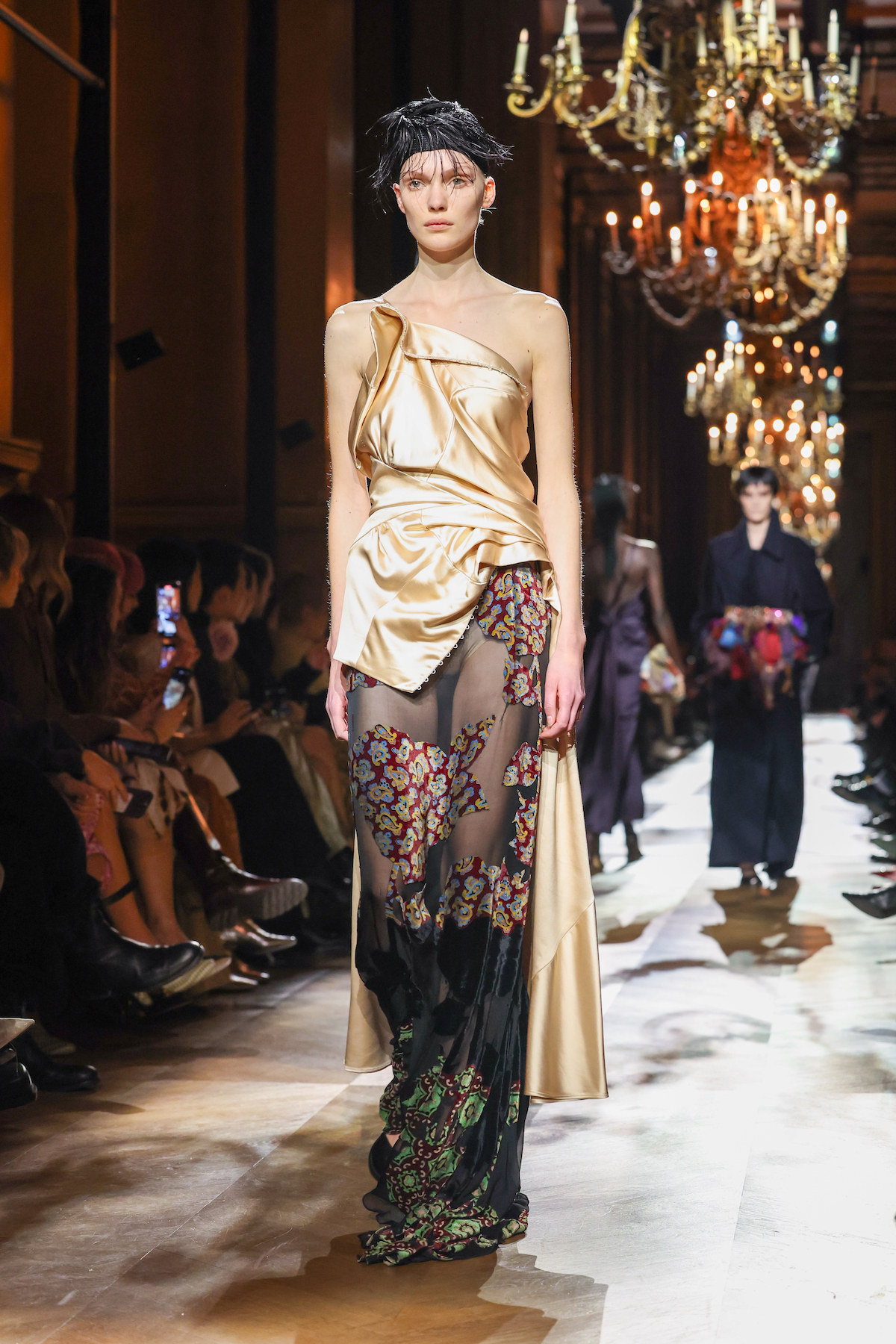
In the first of two debuts of the day – Haider Ackermann would present his first Tom Ford collection later that evening – Belgian designer Julian Klausner heralded the start of a new era at Dries Van Noten, taking over from the eponymous founder who made his exit last June. Having worked at he house since 2018, and arriving with the full blessing of Van Noten himself, the show at the Opéra Garnier was less about a full-scale revolution than it was about a steady transition from one designer to the next.
The show’s setting was a clue to the inspiration: Klausner imagined his protagonist for the season dashing through the gilded opera house grabbing pieces of fabric and wrapping them around her body intuitively, tied with shoelaces. As such, there was a sense of improvisation to the silhouette: a halterneck top appeared crafted from a handful of silk scarves, while dresses wrapped cleverly around the body, as if thrown on in haste. Opulent fabrications – sometimes clashing – nodded towards Van Noten’s own mastery of texture and print, though here there was bolder eclectism, like a series of garments adorned with hundreds of different curtain ties, or the amalgam of paillettes, animal prints, checks or brocade.
‘Looking back, I realised I made this collection in a very instinctive way,’ he said after the show. ‘I went towards things I always loved. I thought about the fact that the first time I fell in love with fashion was as a child playing in the costume box, just grabbing things that you love, combining them, mixing them. Dries wanted me to feel the freedom of doing it alone.’ JM
Courrèges
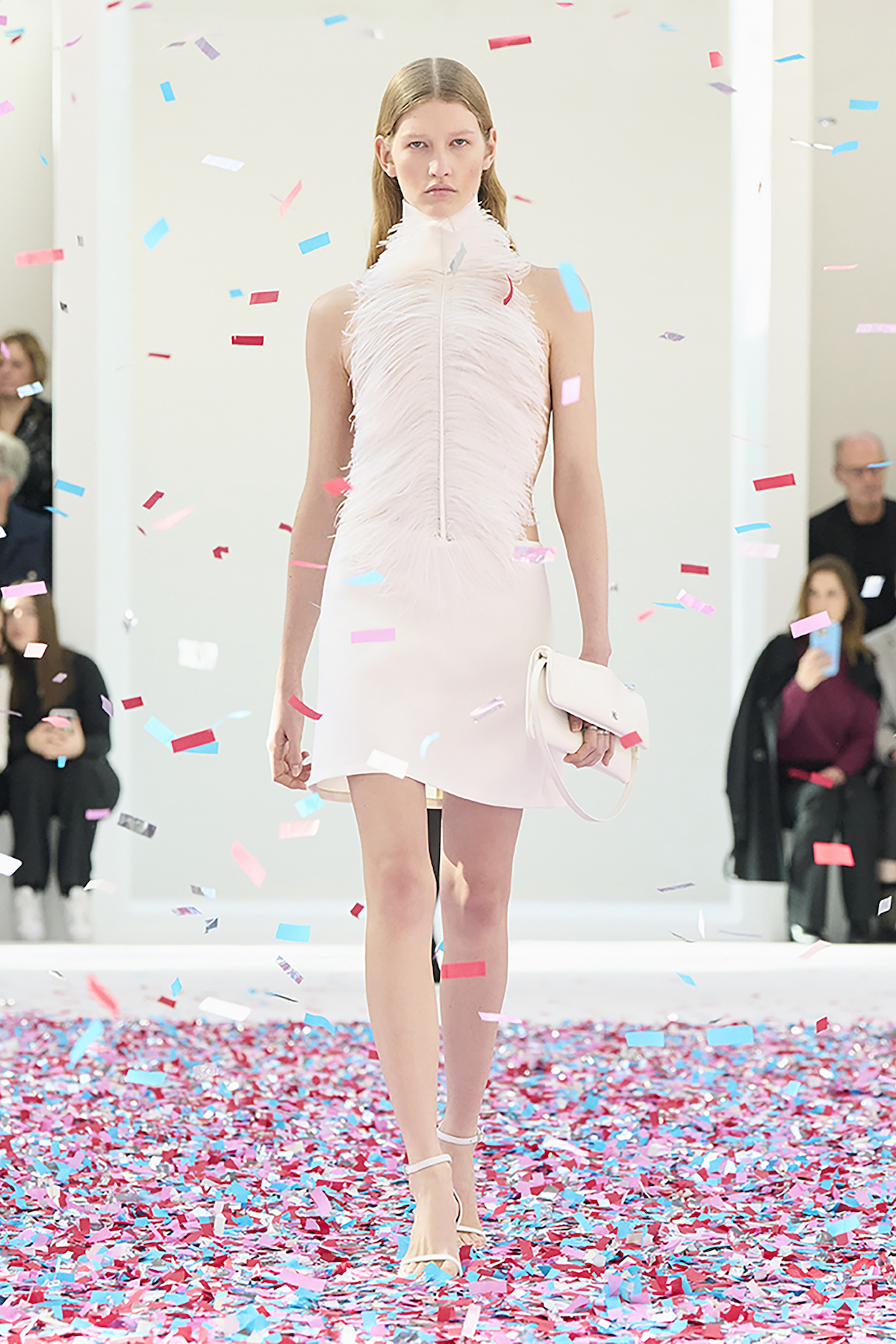
Nicolas Di Felice said he wanted to mine a feeling of optimism this season at Courrèges, despite what he admits are increasingly ‘uncertain times’. Set to a remix of Chantal’s 1990 house classic ‘The Realm’ and centred around a flurry of pink confetti cleverly conceived by French set designer Rémy Briere, Di Felice called the runway ‘a place to unite, to gather – a safe space for joy and togetherness’ akin to his beloved raves (the Belgian designer grew up in the 1990s rave scene, a constant touch point of his work).
It lent the collection a looser, more intuitive feel: a series of dresses, which wrapped cleverly around the body, were based on the idea of throwing on a scarf (the silhouette ran throughout, and was also inspired by the elongated rectangle shape of a streamer), while enormous ostrich feathers became tops (the musician Arca was already wearing one front row). Meanwhile archetypal garments – like the tank top, or the biker jacket – were twisted at their seams into intriguing new proportions, often with the illusion that they were slipping off the body.
‘This collection started from the first time I was pessimistic in my life, which was not like me at all, last season,’ Di Felice explained backstage, noting that photographs of confetti by the artist Dan Colen had brought him back to life. ‘So this [collection] is the total opposite. I found myself so happy, full of joy, an optimist again.’ JM
Alaïa
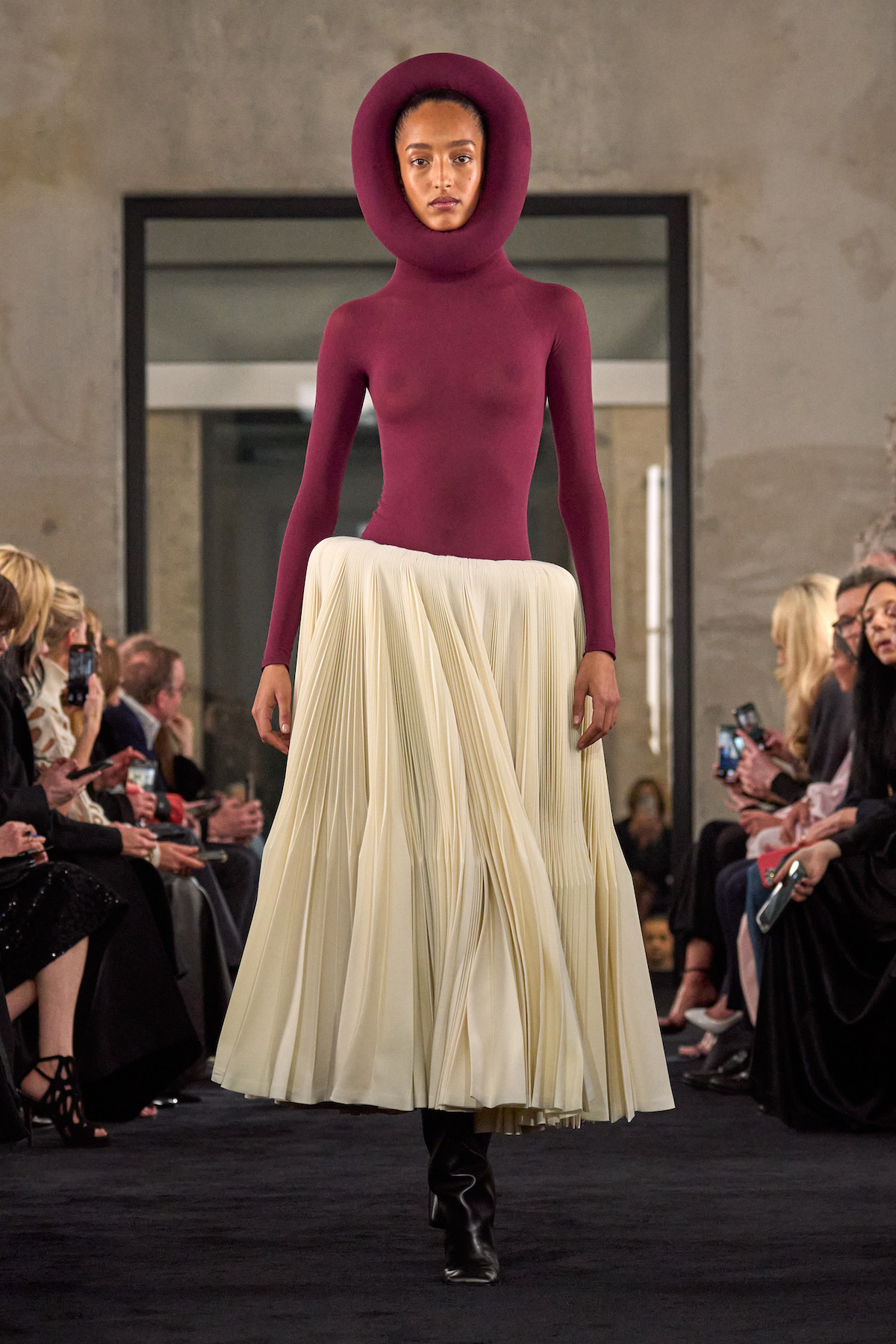
Marking a return to Paris after showing at New York’s Guggenheim Museum last season, Pieter Mulier staged his latest collection in the Alaïa atelier on Rue Servan. Populating the space were a series of monolithic heads in roughly hewn unfired clay by the contemporary Dutch artist Mark Manders. Mulier said he was drawn to the works for the way they appear to stand outside of time or place: ‘Manders’ work fascinates me – each of his sculptures seem itself a work either in progress, or marked by the passage of an imaginary time, reminiscent at once of many different cultures,’ he said. ‘And that idea of a non-linearity – of space, and of time – was inspiring.’
The idea of non-linearity – of garments which traversed time and space, a ‘beauty outside of any era or geography, free of boundaries’ – ran through the standout collection. Referencing at once ancient deities (on his Instagram prior to the show, he posted a carved Bronze Age figure of a woman, captioned ‘Modern Venus’) and the archival designs of house founder Azzedine Alaïa (notably, a focus on hooded silhouette and pleats), the resulting garments were what Mulier called ‘kinetic sculptures’. Romantic flourishes came in heart-shaped cut-outs and flower-like pom poms at the neckline, while looping gowns – held in place with twists of metal – continued the ‘gravity-defying’ silhouettes of last season.
‘The message is about singularity, individuality, the eternal strength and resilience of women, empowering them through their clothes,’ Mulier continued. ‘That always inspired Azzedine, and it always inspires me – the strength of beauty.’ JM
Dior
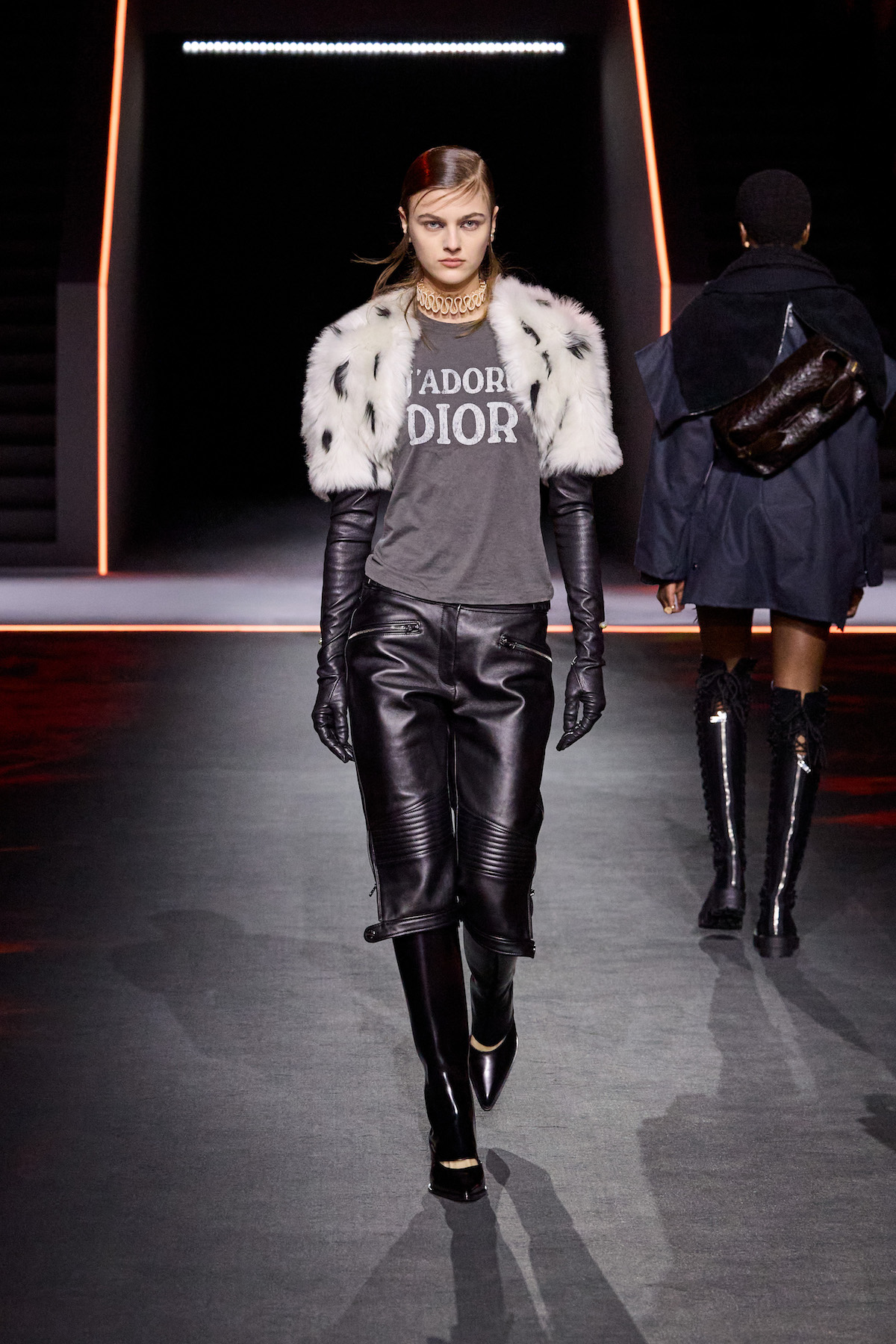
The idea of metamorphosis was at the centre of Maria Grazia Chiuri’s latest collection for Dior, an idea reflected in a theatrical mise-en-scène by the experimental American theatre director Robert Wilson which recreated the dawn of time in his symbolic style (from jagged glaciers that rose from the floor to a pterodactyl which zoomed across the space). Grazia Chiuri’s collection had also begun with something elemental, at least in fashion terms: the white shirt, which she linked with Gianfranco Ferré, who led the house in the late 1980s and early 1990s, and who was an influence here.
The foundational garment became a jumping off point for an exploration of historic dress codes, layered under corsetry or dramatically ruffled and elongated at the cuff, chiming with the Elizabethan-inflected frock coats, ruff-inspired pearl necklaces and flared-waist crinoline gowns elsewhere (Virginia Woolf’s Orlando, and its time-travelling, gender-shifting protagonist, were another inspiration). Meanwhile, tough black leather met playful faux-ermine stoles, while slouchy parka-style outerwear prevented the collection from feeling like costume. Grazia Chiuri also reintroduced the John Galliano-era J’Adore Dior T-shirt, including a version given new life with patches of delicate lace. ‘A femininity that imagines possible futures by mixing evocations of a past,’ the designer described. JM
Stay tuned for more from Paris Fashion Week A/W 2025.
Jack Moss is the Fashion Features Editor at Wallpaper*, joining the team in 2022. Having previously been the digital features editor at AnOther and digital editor at 10 and 10 Men magazines, he has also contributed to titles including i-D, Dazed, 10 Magazine, Mr Porter’s The Journal and more, while also featuring in Dazed: 32 Years Confused: The Covers, published by Rizzoli. He is particularly interested in the moments when fashion intersects with other creative disciplines – notably art and design – as well as championing a new generation of international talent and reporting from international fashion weeks. Across his career, he has interviewed the fashion industry’s leading figures, including Rick Owens, Pieter Mulier, Jonathan Anderson, Grace Wales Bonner, Christian Lacroix, Kate Moss and Manolo Blahnik.
-
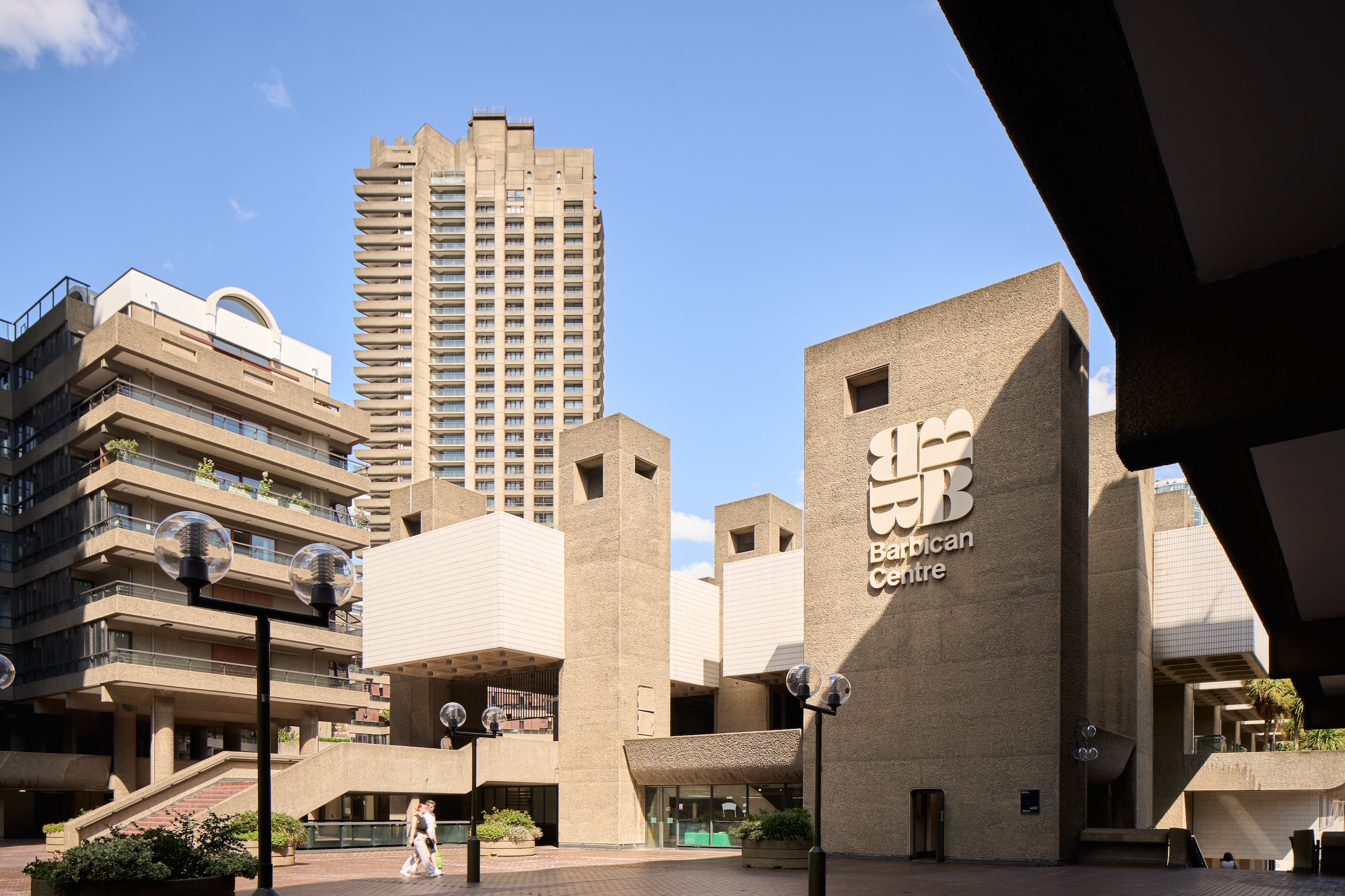 Warp Records announces its first event in over a decade at the Barbican
Warp Records announces its first event in over a decade at the Barbican‘A Warp Happening,' landing 14 June, is guaranteed to be an epic day out
By Tianna Williams
-
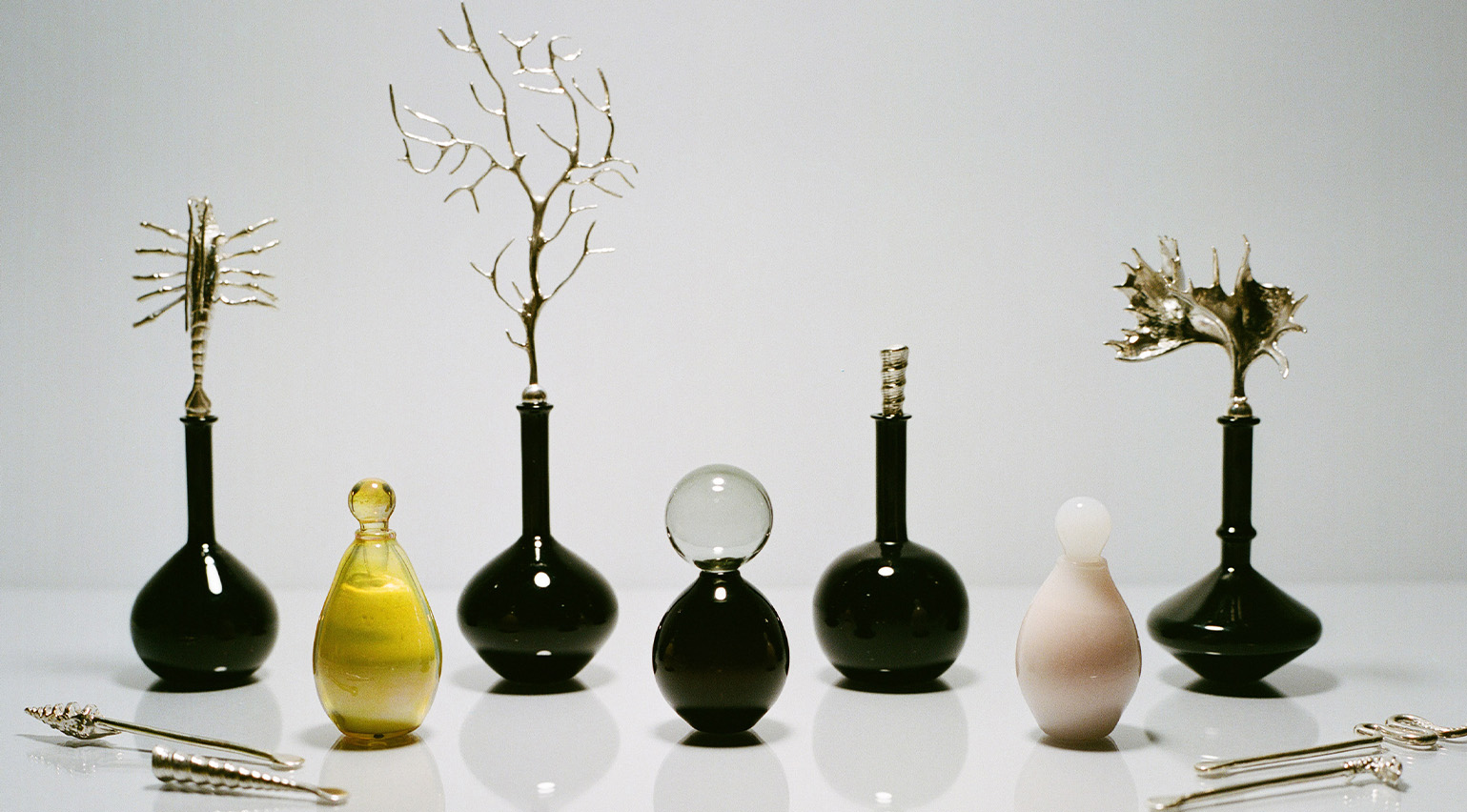 Cure your ‘beauty burnout’ with Kindred Black’s artisanal glassware
Cure your ‘beauty burnout’ with Kindred Black’s artisanal glasswareDoes a cure for ‘beauty burnout’ lie in bespoke design? The founders of Kindred Black think so. Here, they talk Wallpaper* through the brand’s latest made-to-order venture
By India Birgitta Jarvis
-
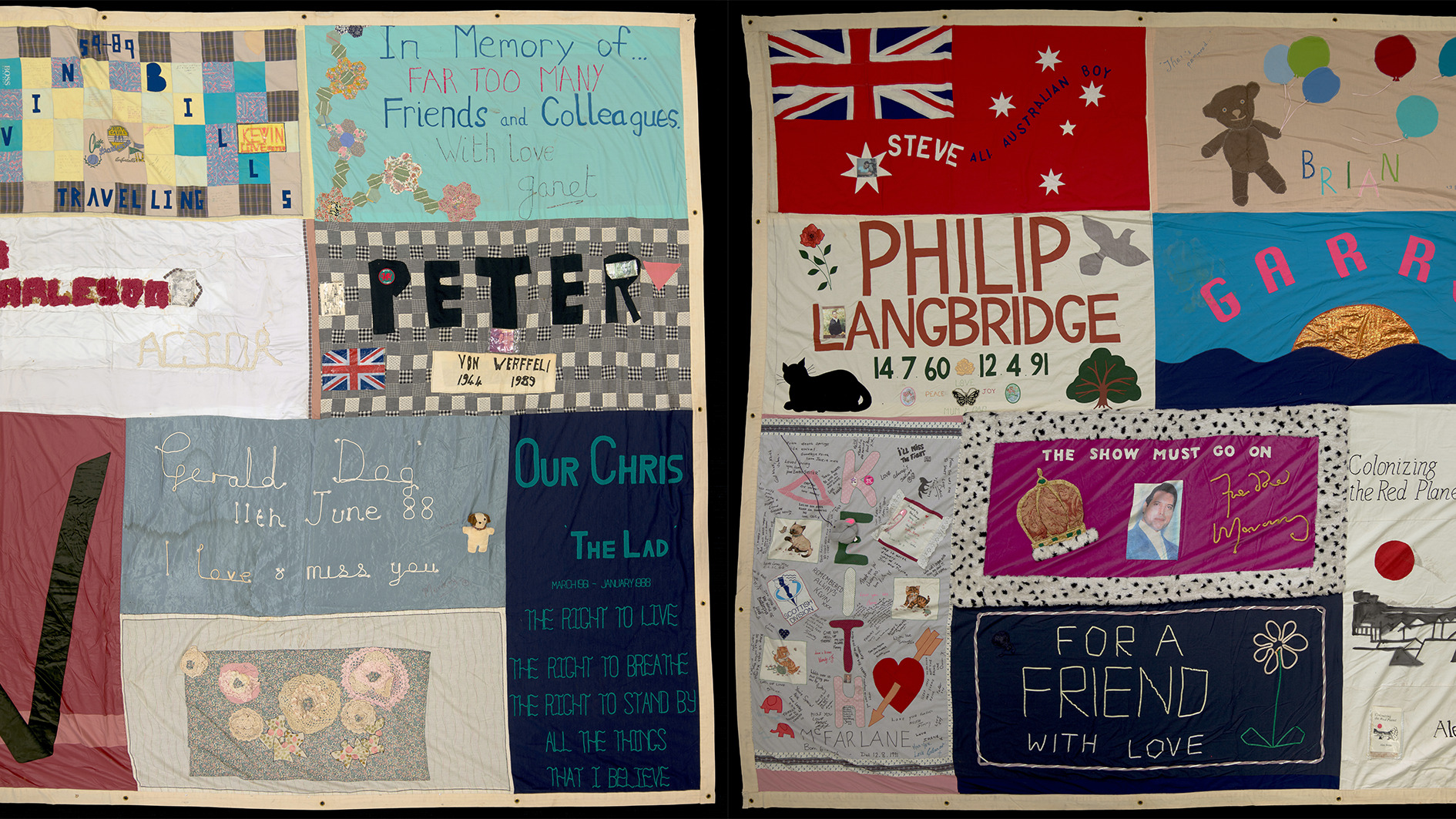 The UK AIDS Memorial Quilt will be shown at Tate Modern
The UK AIDS Memorial Quilt will be shown at Tate ModernThe 42-panel quilt, which commemorates those affected by HIV and AIDS, will be displayed in Tate Modern’s Turbine Hall in June 2025
By Anna Solomon
-
 With scenography by OMA, Dior’s ‘Designer of Dreams’ exhibition in Seoul is ‘a piece of theatre’
With scenography by OMA, Dior’s ‘Designer of Dreams’ exhibition in Seoul is ‘a piece of theatre’OMA partner Shohei Shigematsu catches up with Wallpaper* about the dramatic show design for the latest iteration of ‘Christian Dior: Designer of Dreams’, which opened in Seoul this weekend
By Daven Wu
-
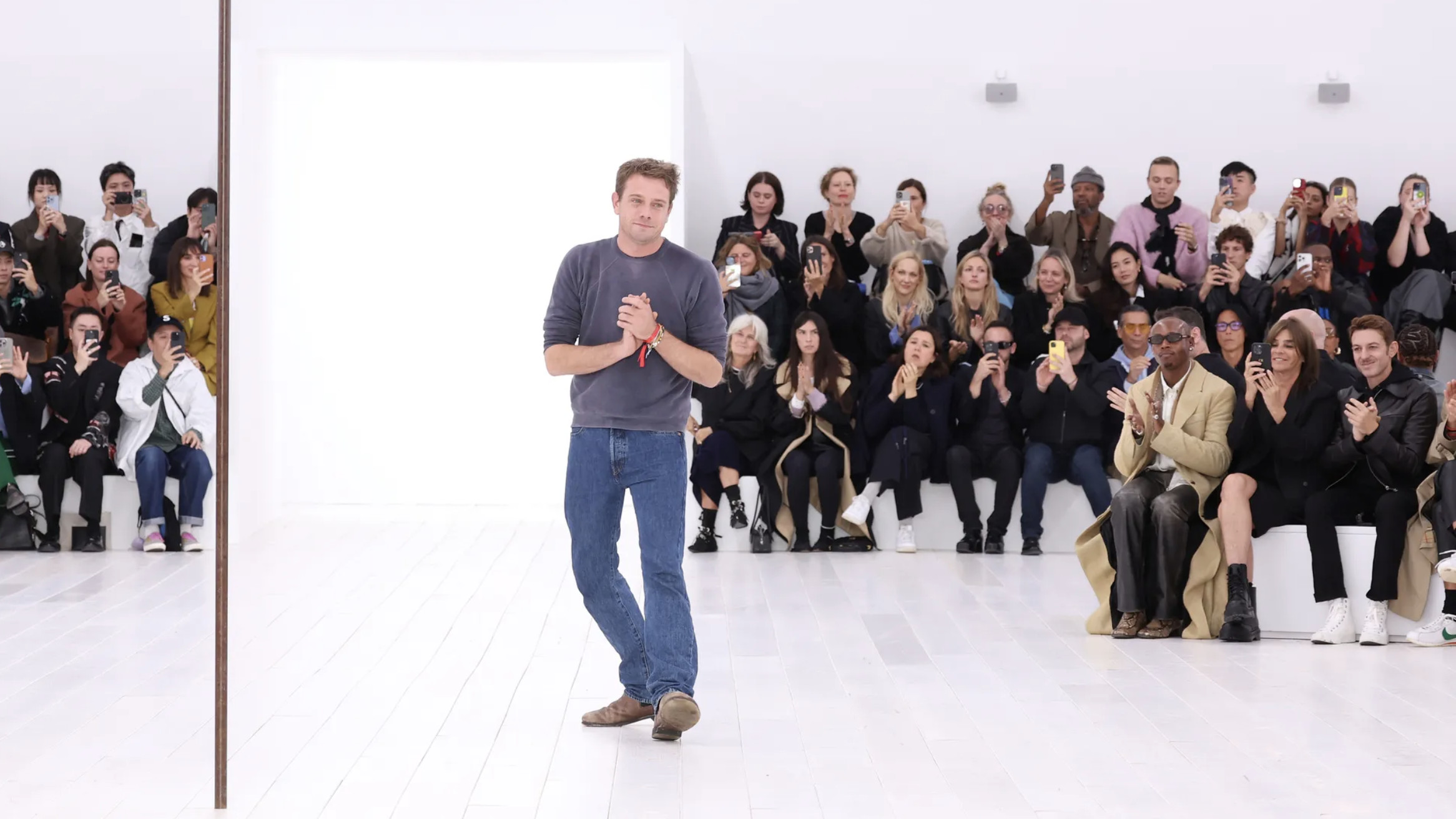 Jonathan Anderson is heading to Dior Men
Jonathan Anderson is heading to Dior MenAfter months of speculation, it has been confirmed this morning that Jonathan Anderson, who left Loewe earlier this year, is the successor to Kim Jones at Dior Men
By Jack Moss
-
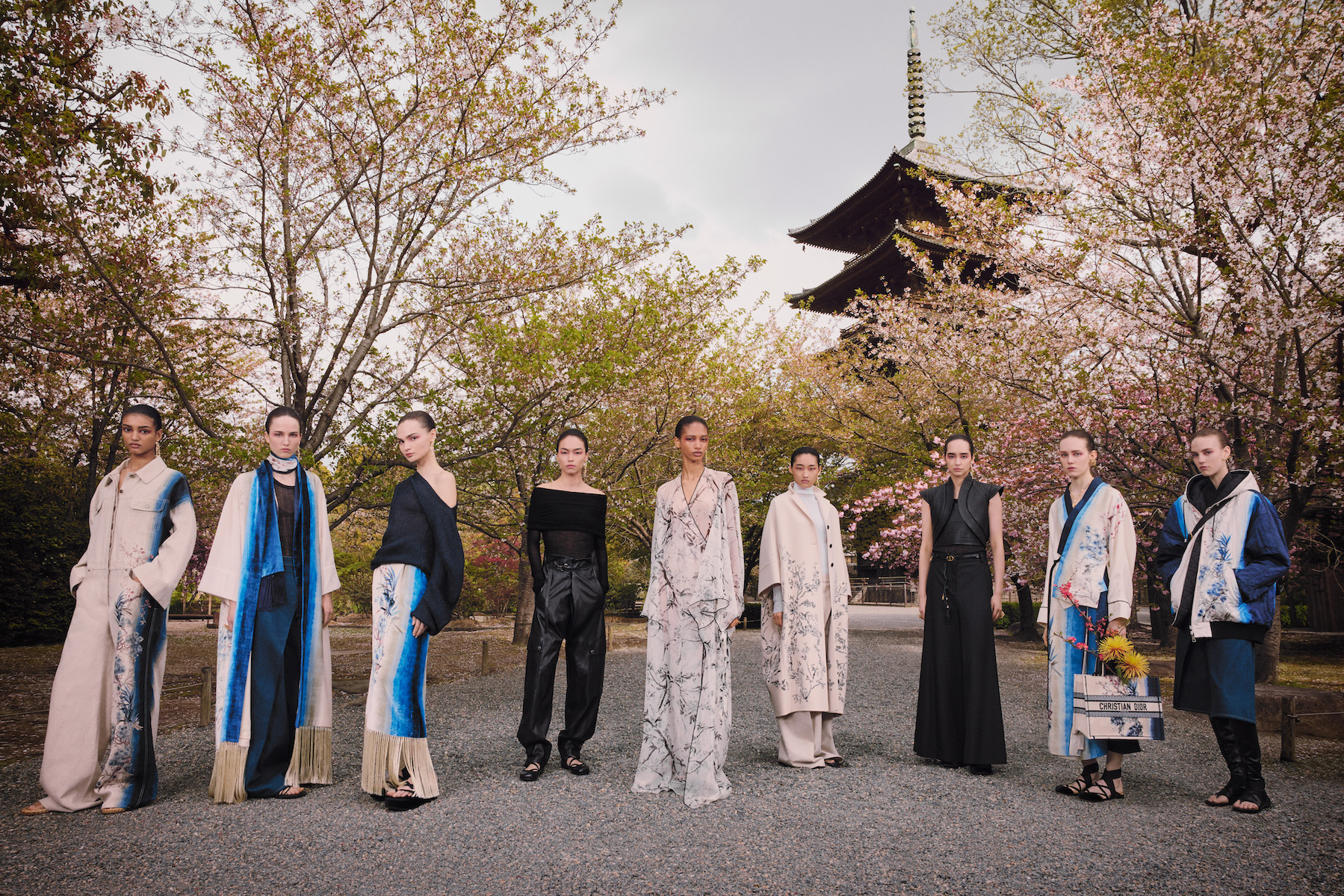 Dior holds an enchanting Kyoto show in the midst of cherry-blossom season
Dior holds an enchanting Kyoto show in the midst of cherry-blossom seasonMaria Grazia Chiuri chose the grounds of Kyoto’s serene Tō-ji Temple to present a Fall 2025 collection that celebrated Dior’s longstanding links with Japan
By Jack Moss
-
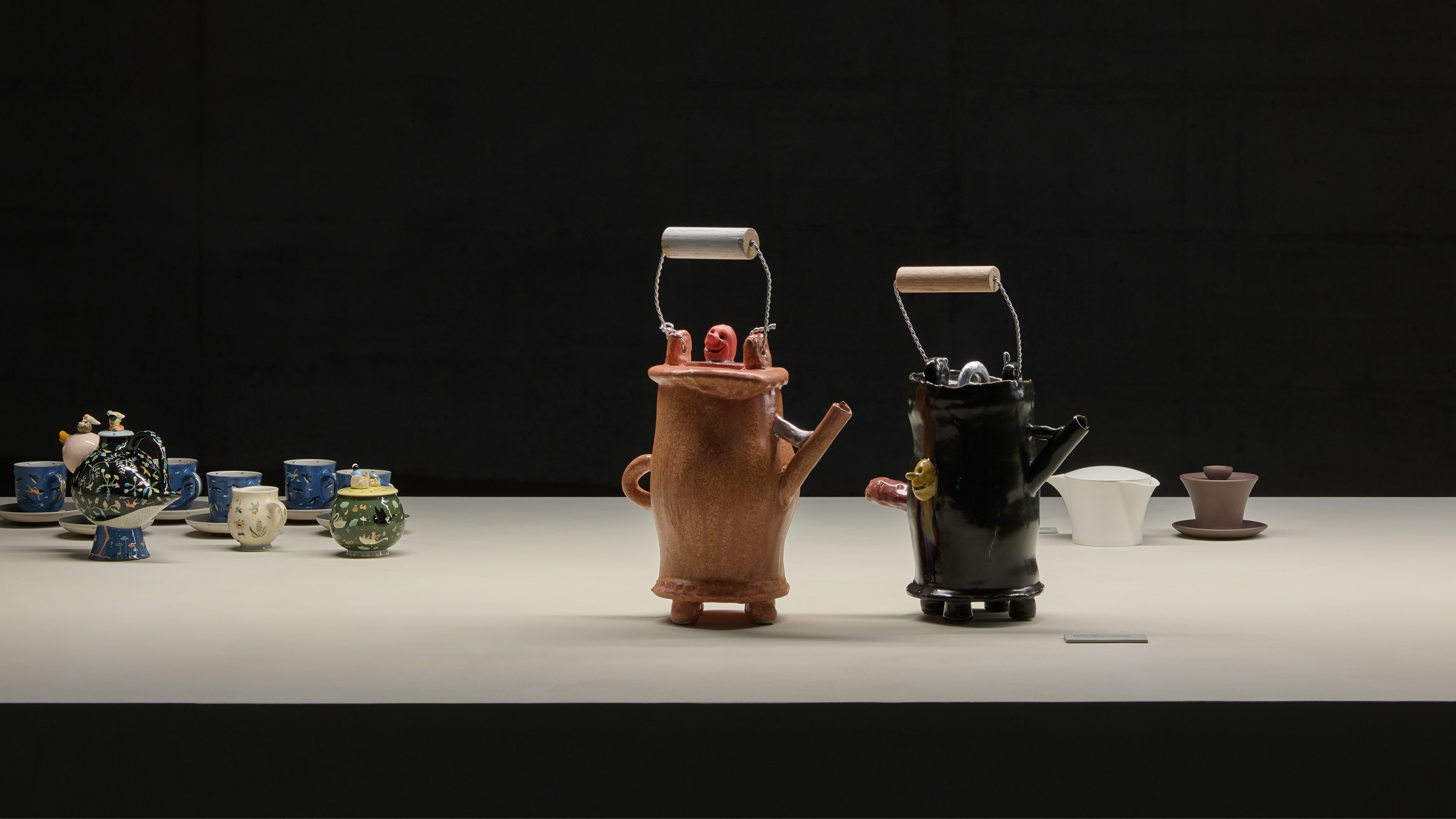 The best fashion moments at Milan Design Week 2025
The best fashion moments at Milan Design Week 2025Scarlett Conlon discovers the finest fashion moments at Salone del Mobile and Milan Design Week 2025, from Loewe’s artist-designed teapots to The Row’s first home collection
By Scarlett Conlon
-
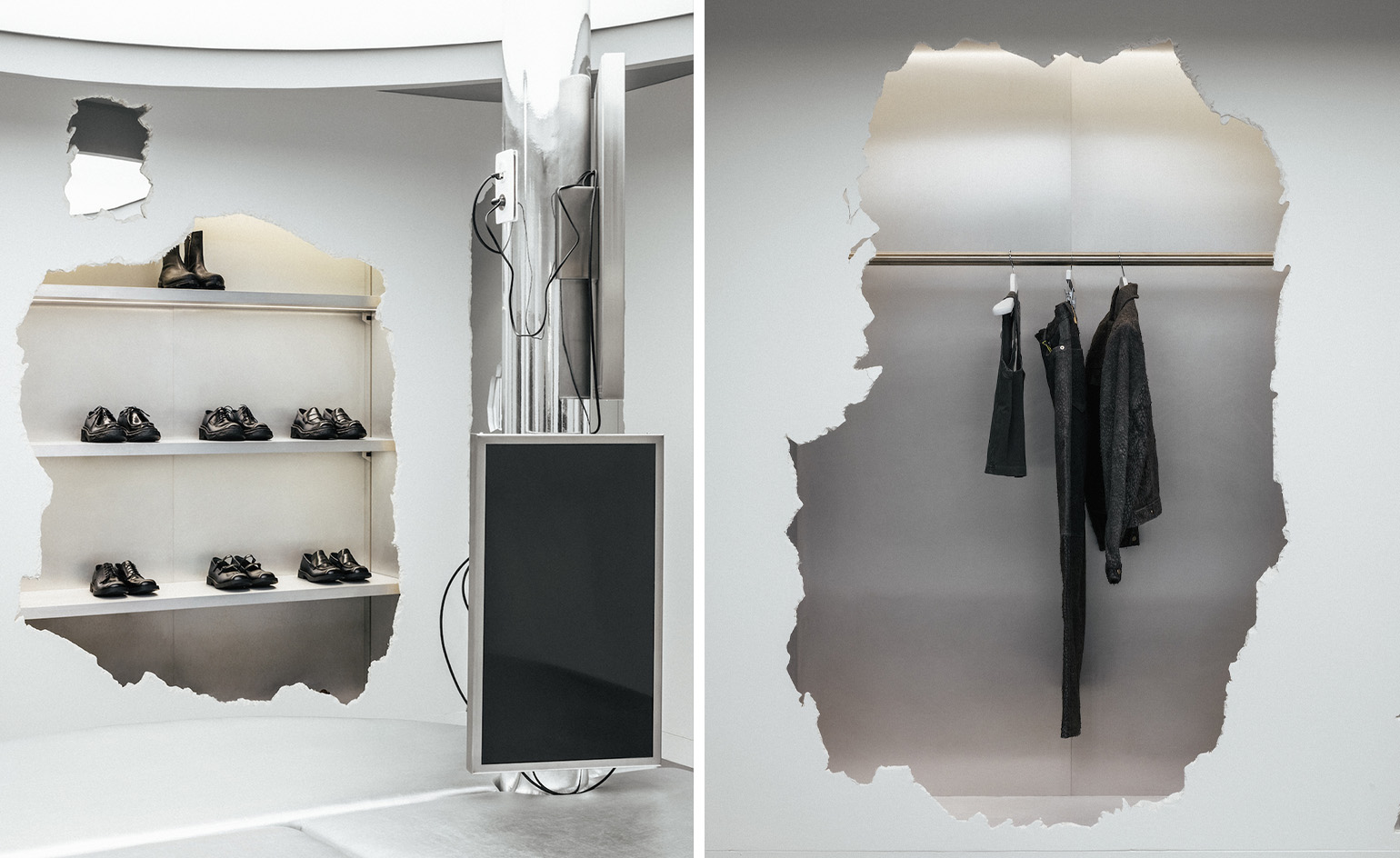 Inside Camperlab’s Harry Nuriev-designed Paris store, a dramatic exercise in contrast
Inside Camperlab’s Harry Nuriev-designed Paris store, a dramatic exercise in contrastThe Crosby Studios founder tells Wallpaper* the story behind his new store design for Mallorcan shoe brand Camperlab, which centres on an interplay between ‘crushed concrete’ and gleaming industrial design
By Jack Moss
-
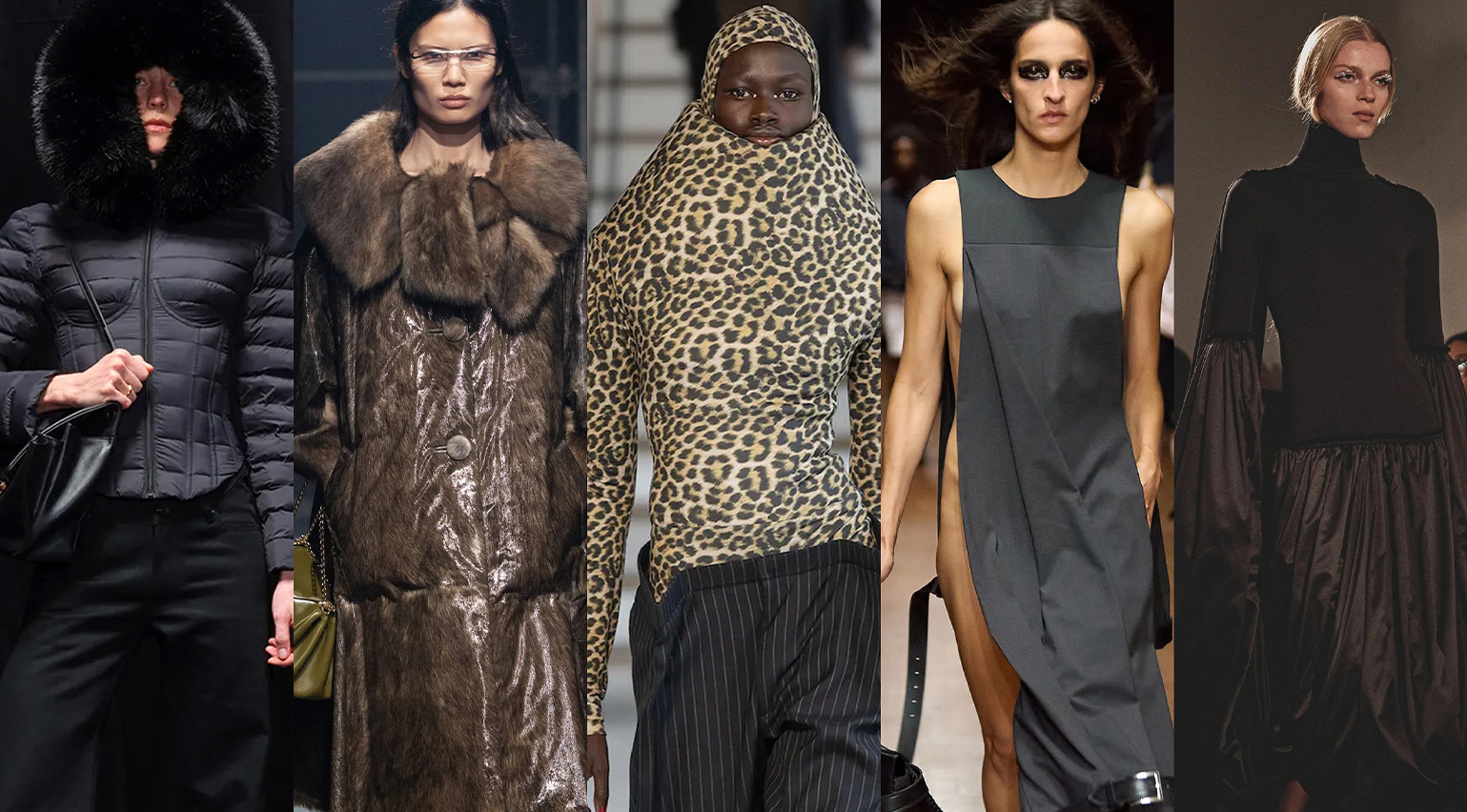 The Wallpaper* A/W 2025 trend report: raw glamour, waistlines and an animal instinct
The Wallpaper* A/W 2025 trend report: raw glamour, waistlines and an animal instinctAs Paris Fashion Week concludes, Wallpaper* fashion features editor Jack Moss unpacks five trends which defined the A/W 2025 season, from ‘raw glamour’ at Prada, sculpted waistlines at Givenchy, to looks made to cocoon and protect
By Jack Moss
-
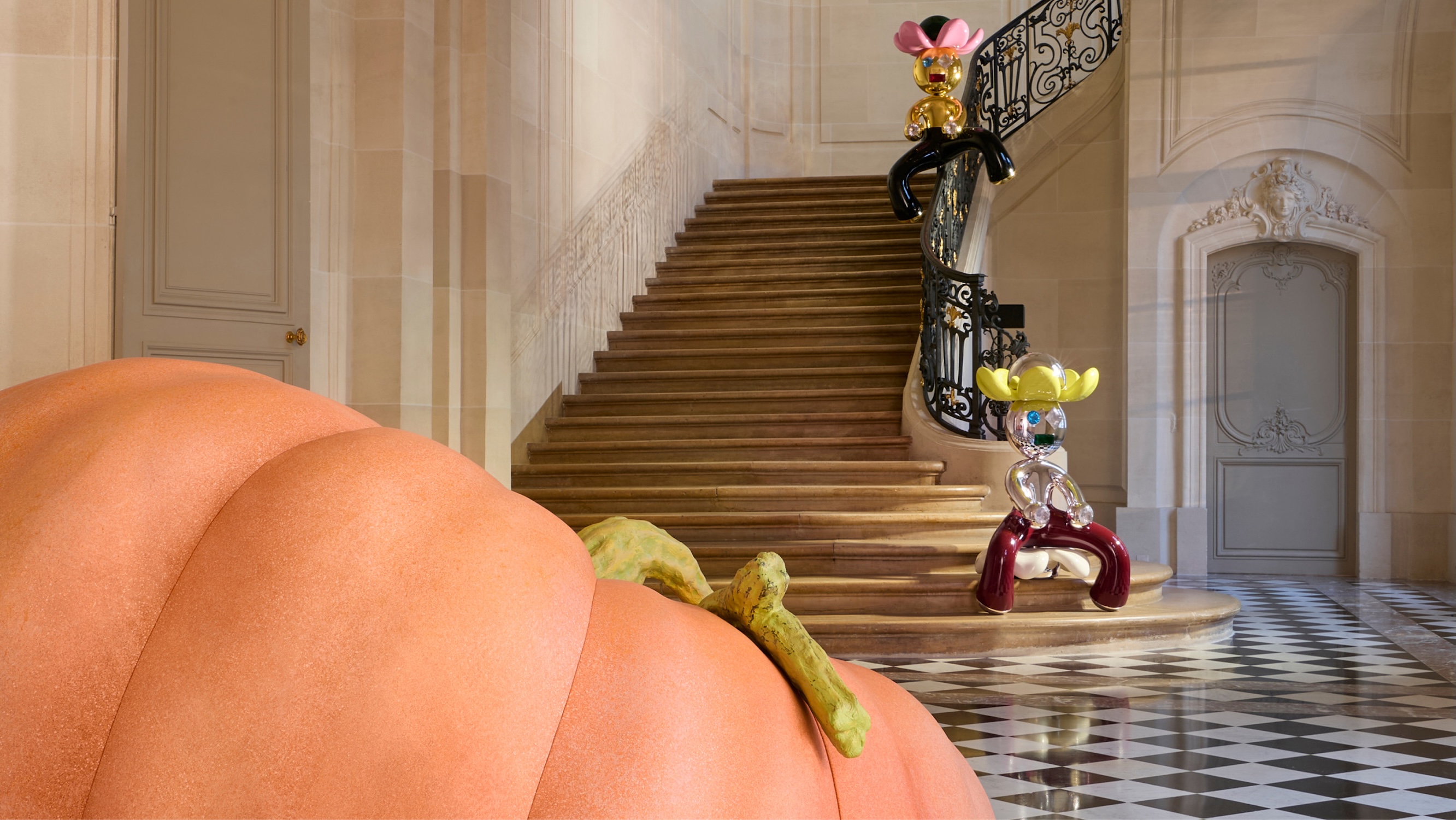 How an 18th-century mansion became a Loewe wonderland for Paris Fashion Week
How an 18th-century mansion became a Loewe wonderland for Paris Fashion WeekDrawing on the act of scrapbooking, Jonathan Anderson took over the Hôtel de Maisons with a self-reflective A/W 2025 presentation, shown alongside colourful artworks from the brand’s collection
By Orla Brennan
-
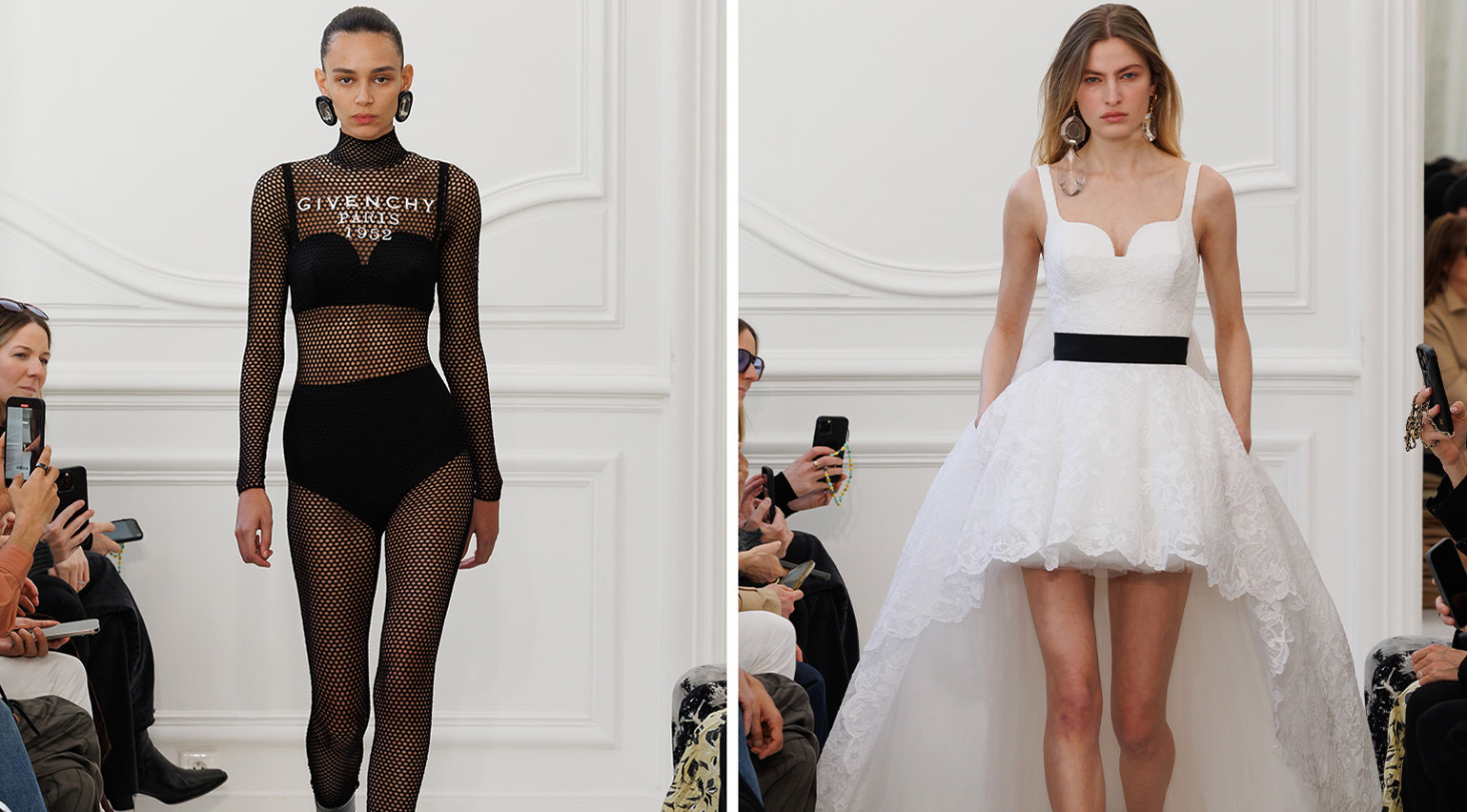 Inside Sarah Burton’s debut show for Givenchy: ‘To go forward, you have to go back to the beginning’
Inside Sarah Burton’s debut show for Givenchy: ‘To go forward, you have to go back to the beginning’This morning in Paris, the former Alexander McQueen designer unveiled her anticipated debut as creative director of Givenchy – a musing on contemporary womanhood sparked by the discovery of lost Hubert de Givenchy pattern pieces
By Jack Moss